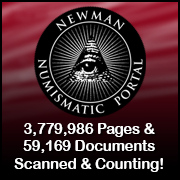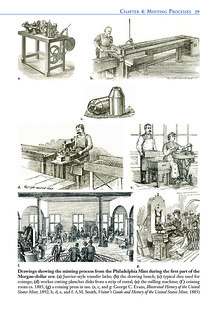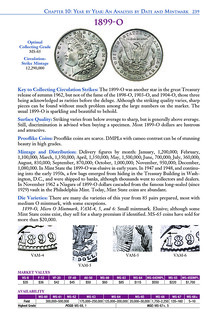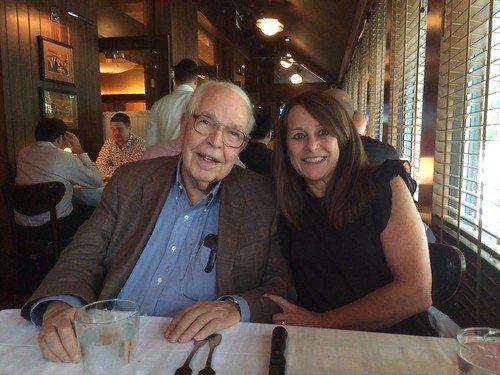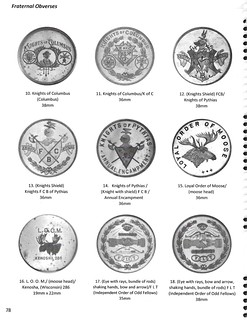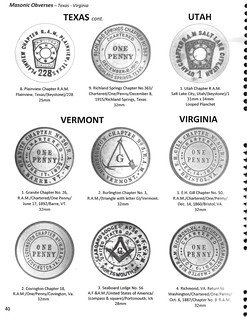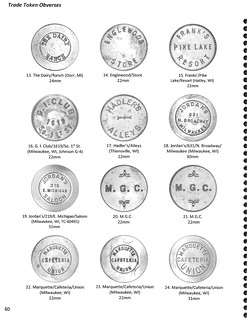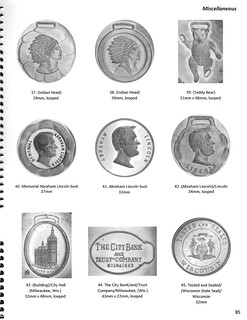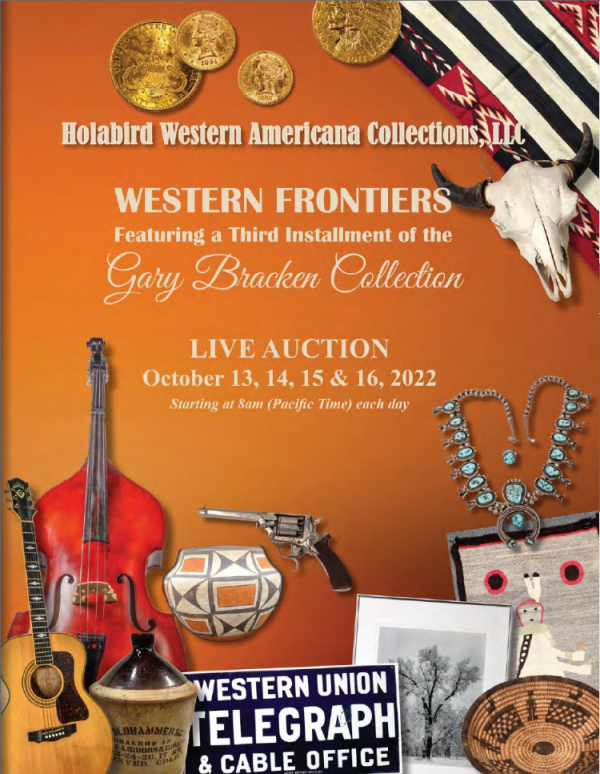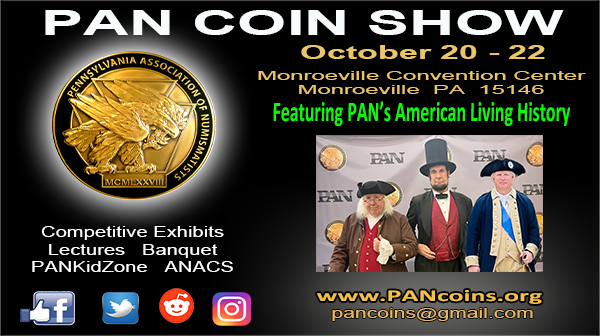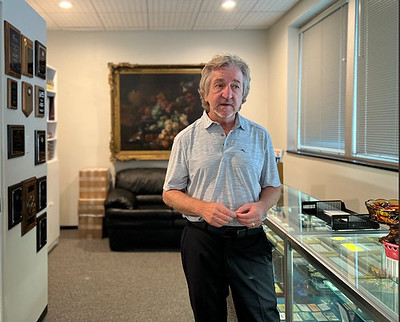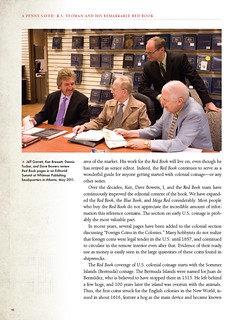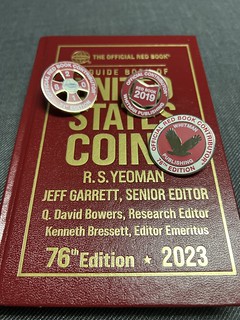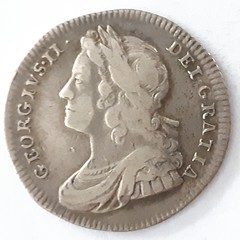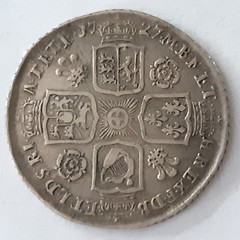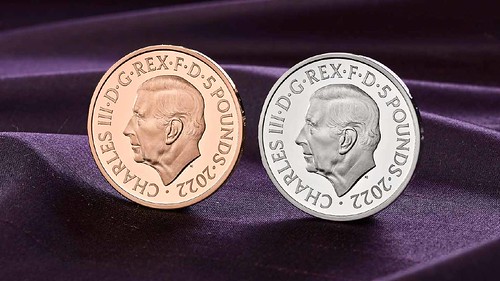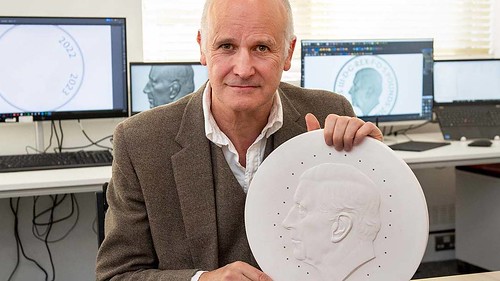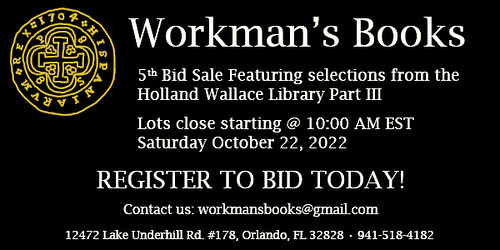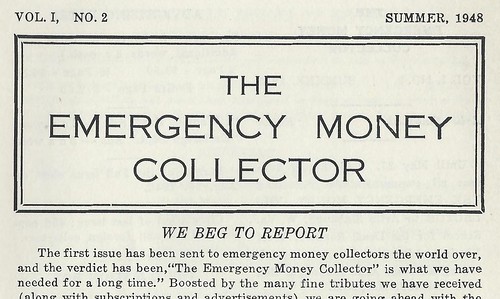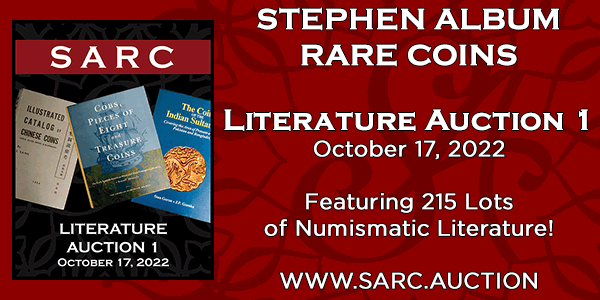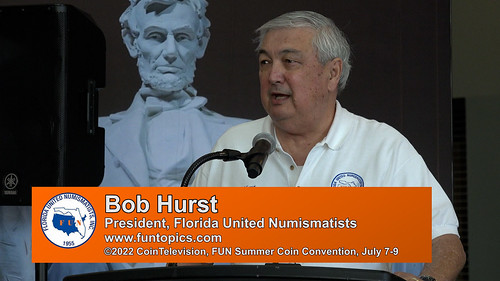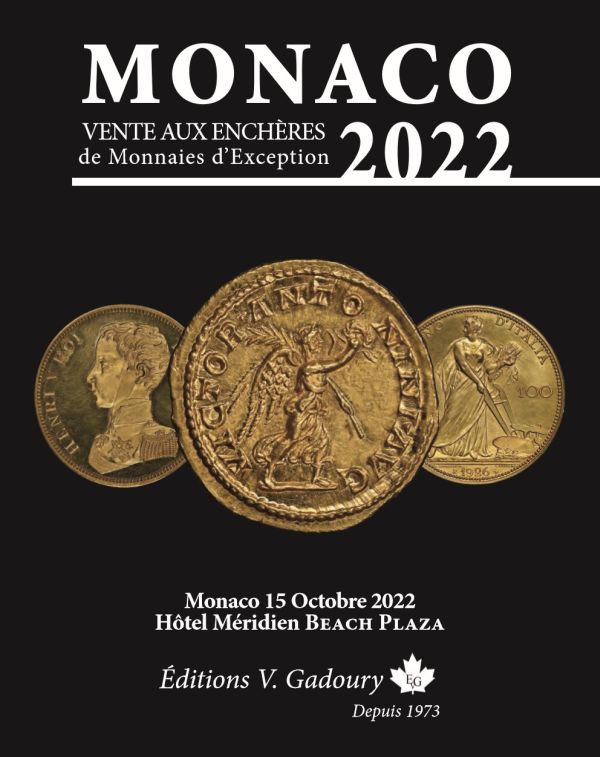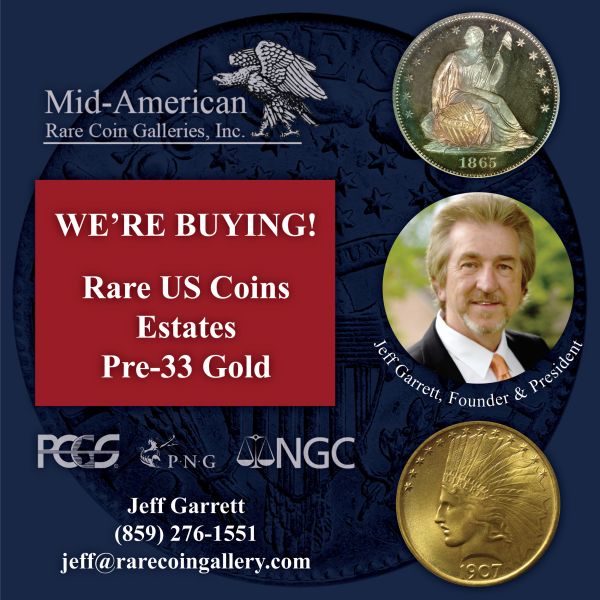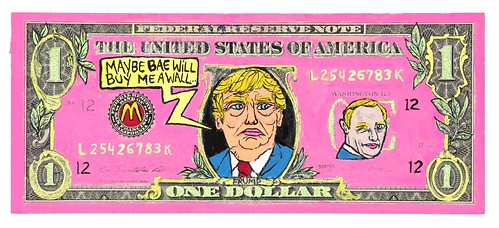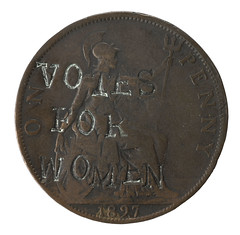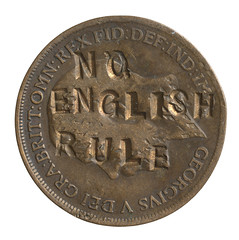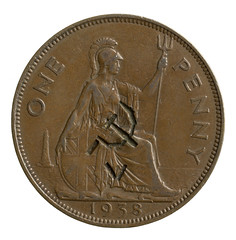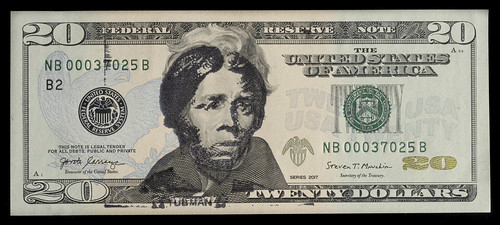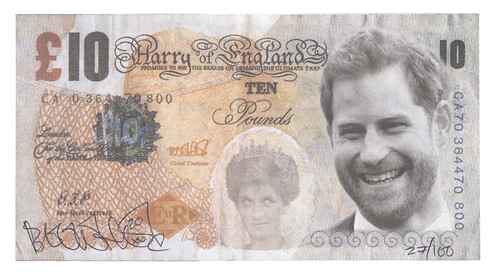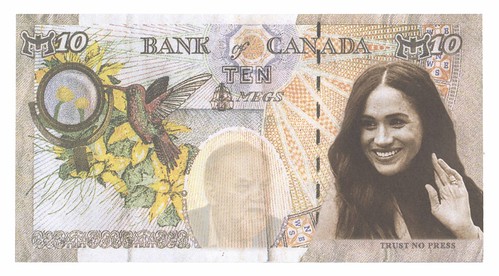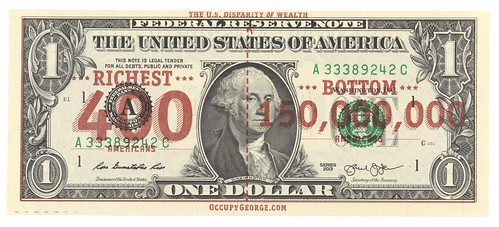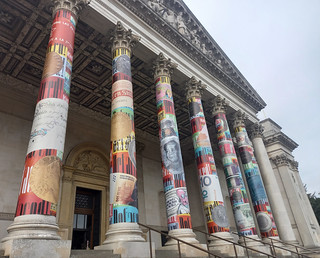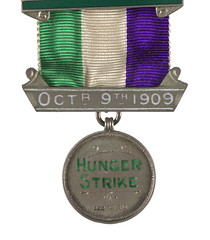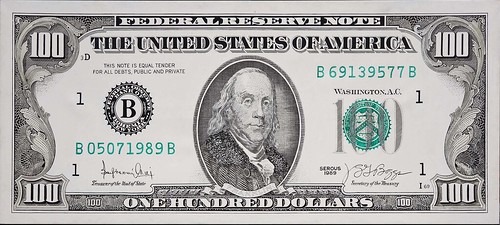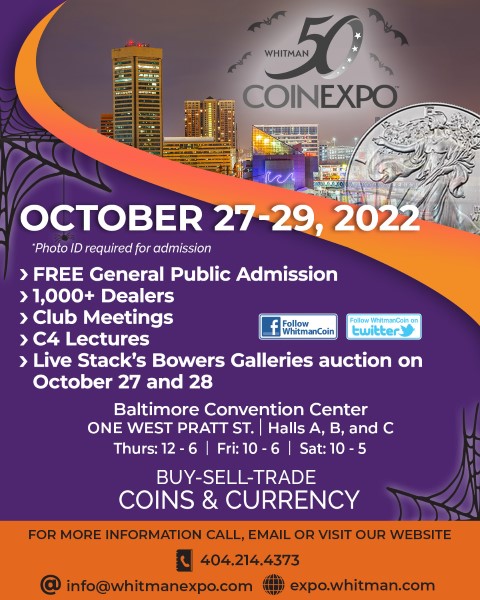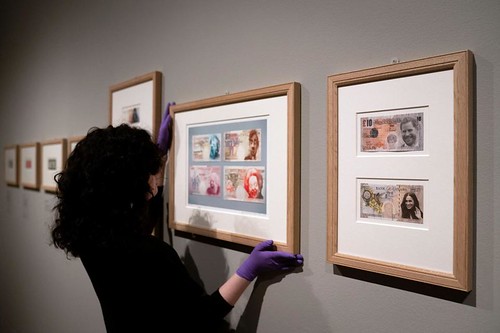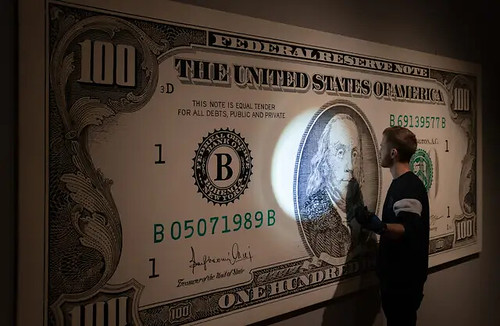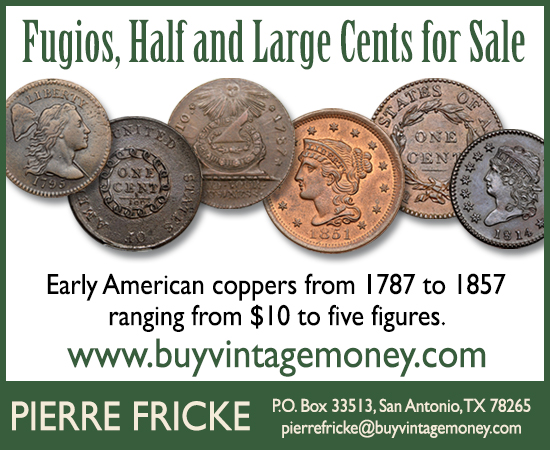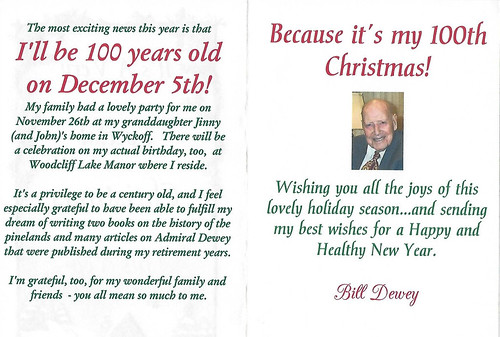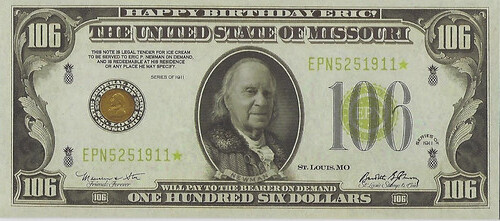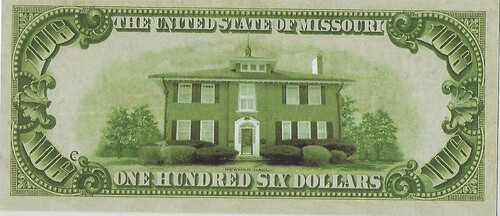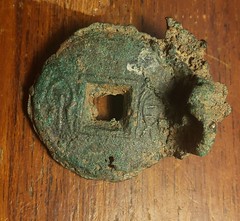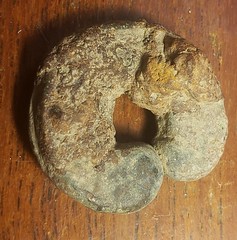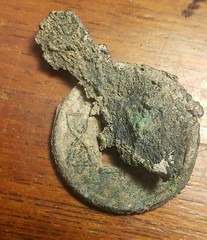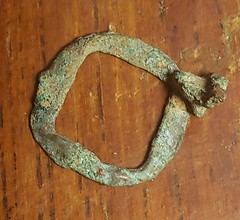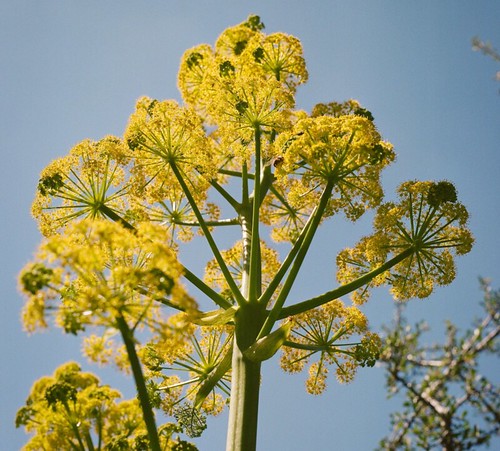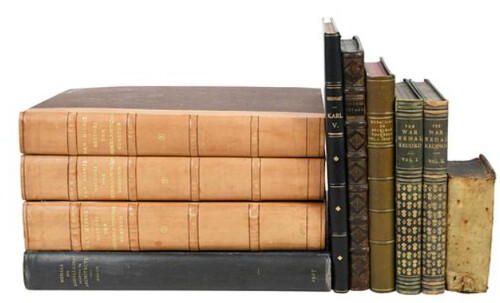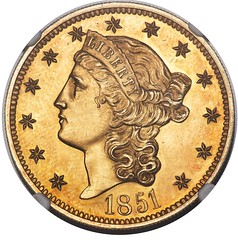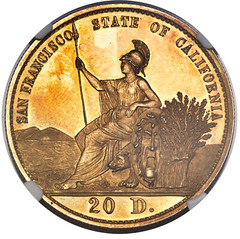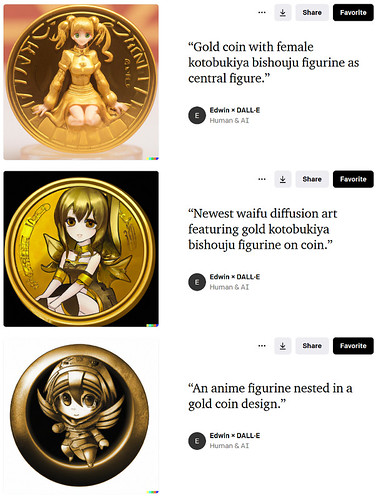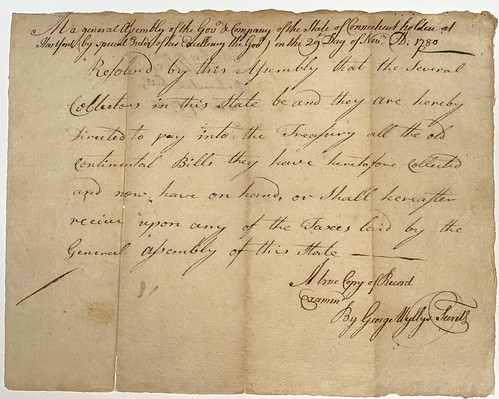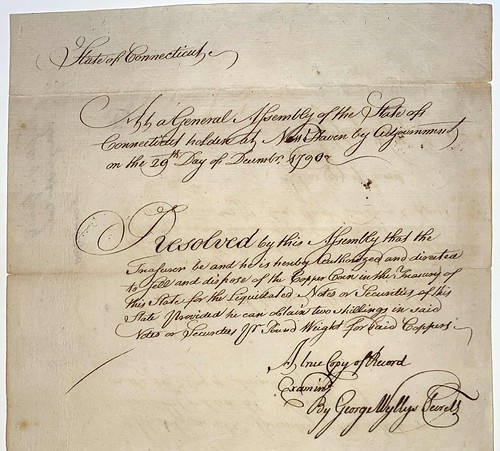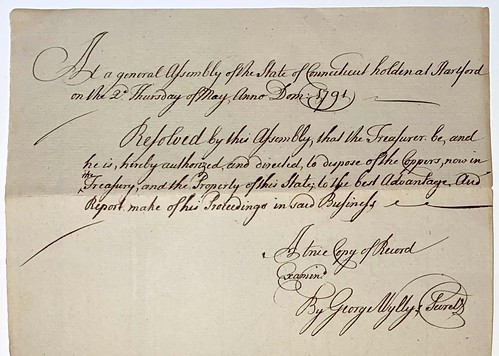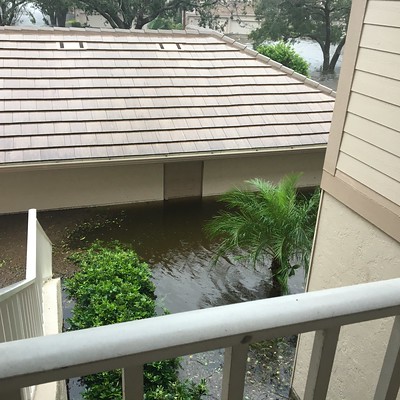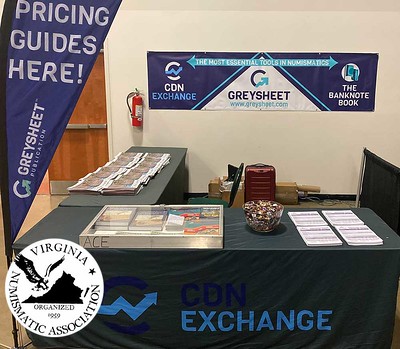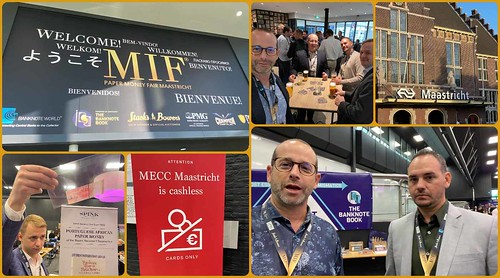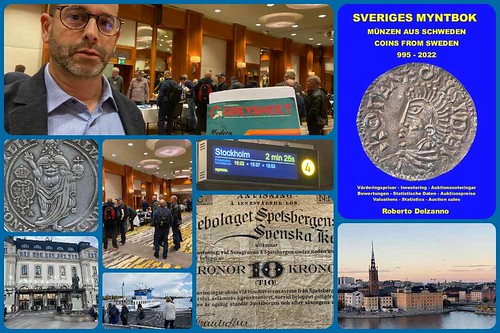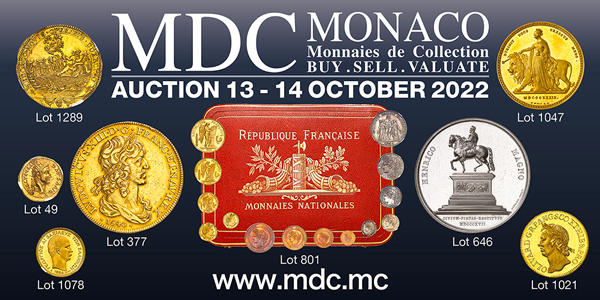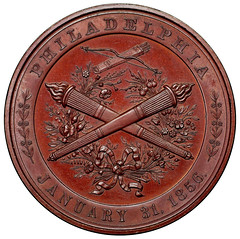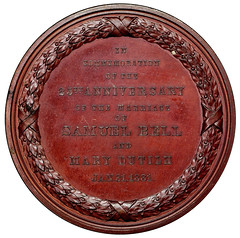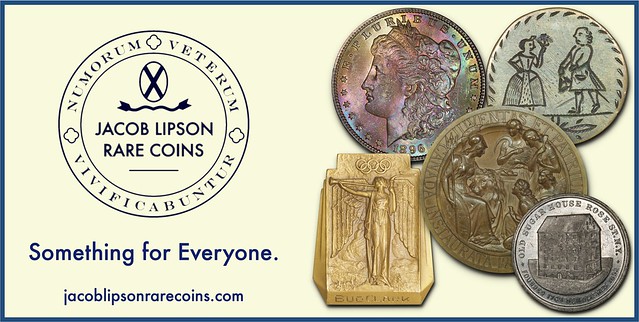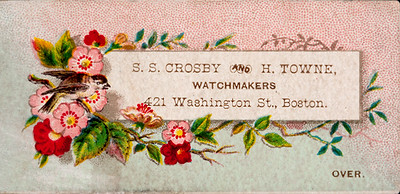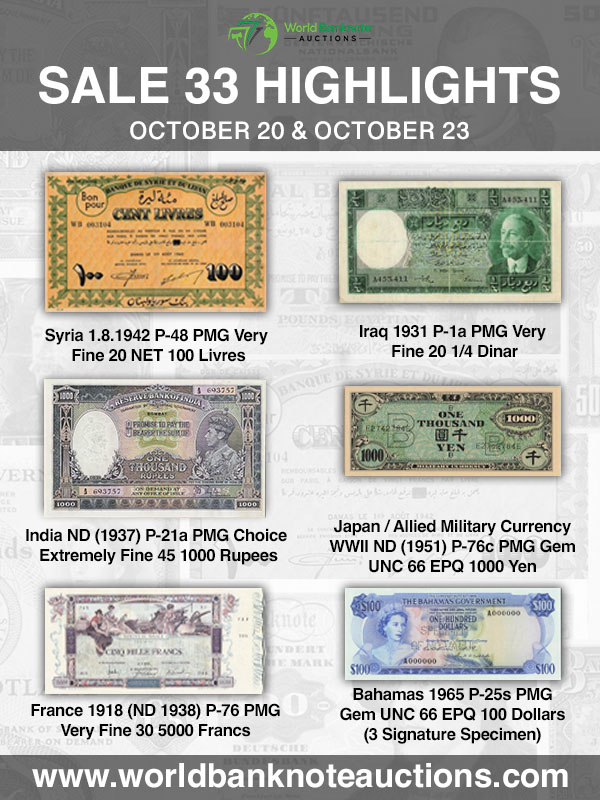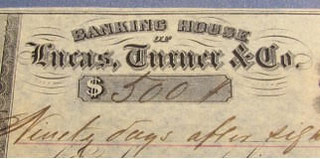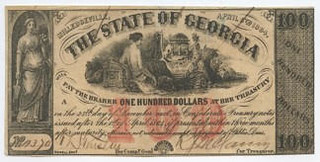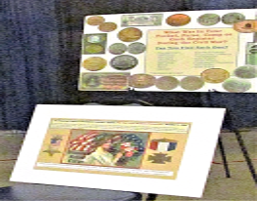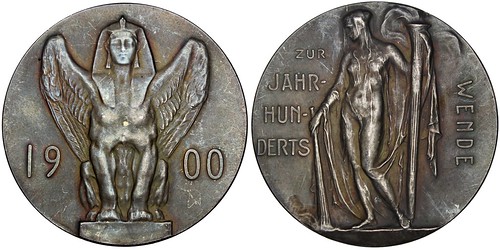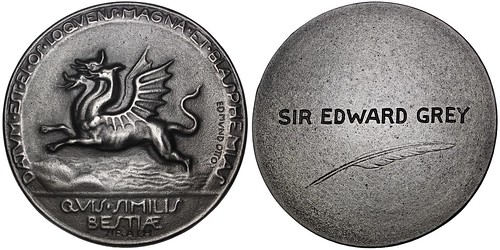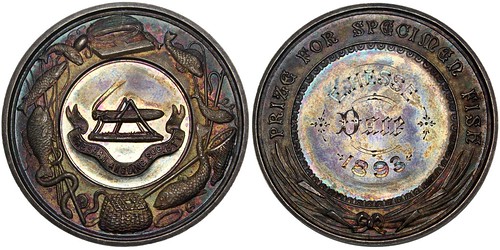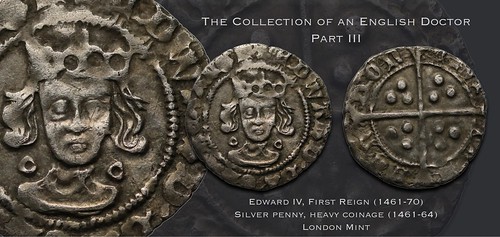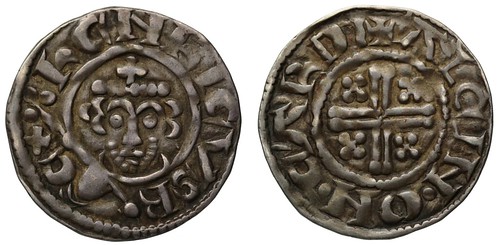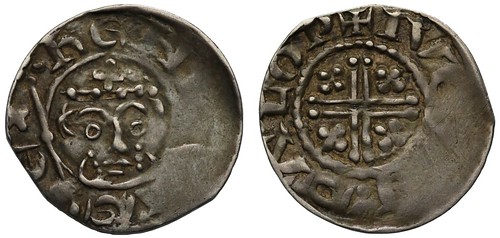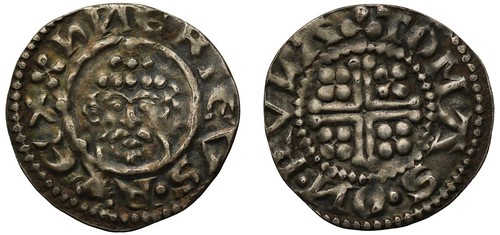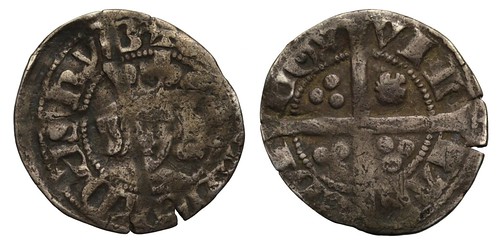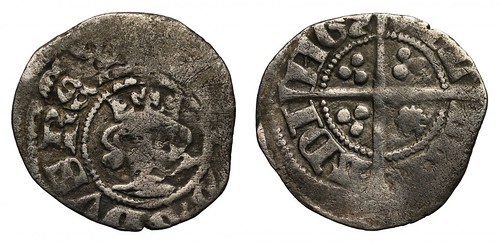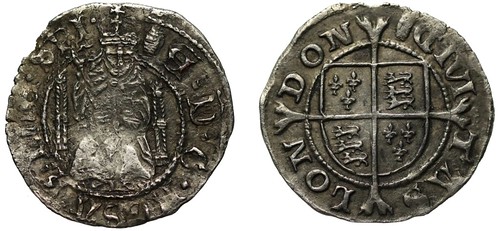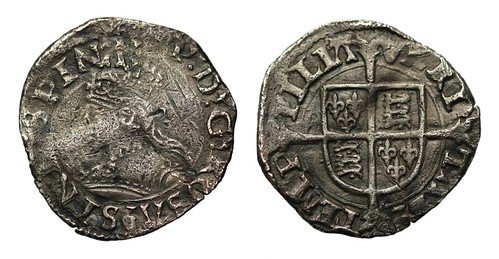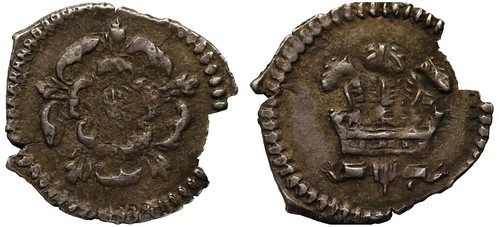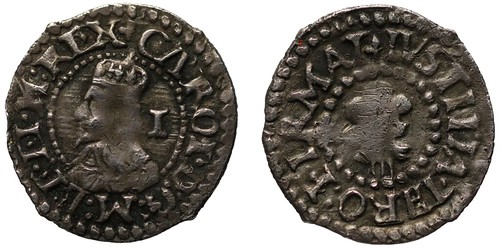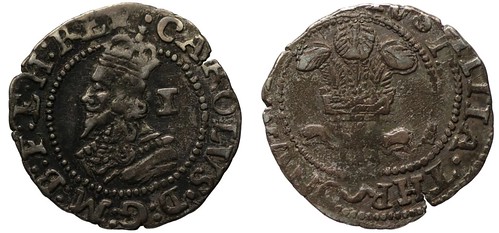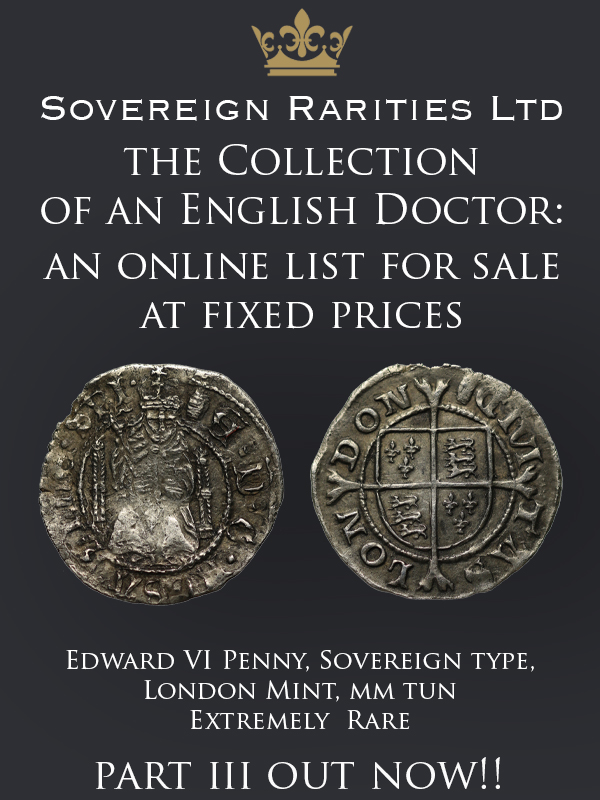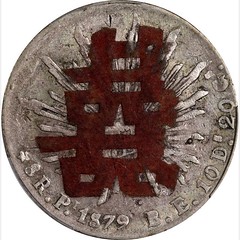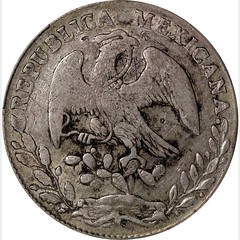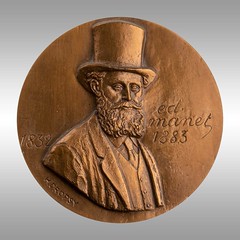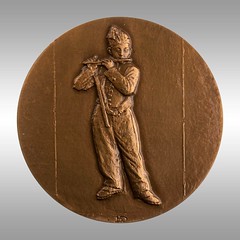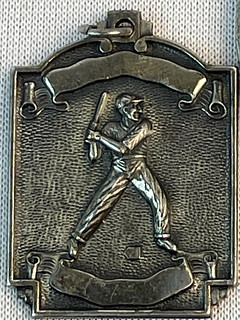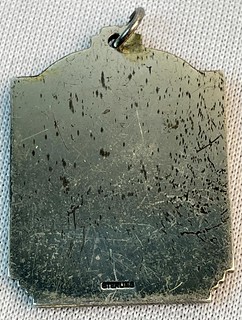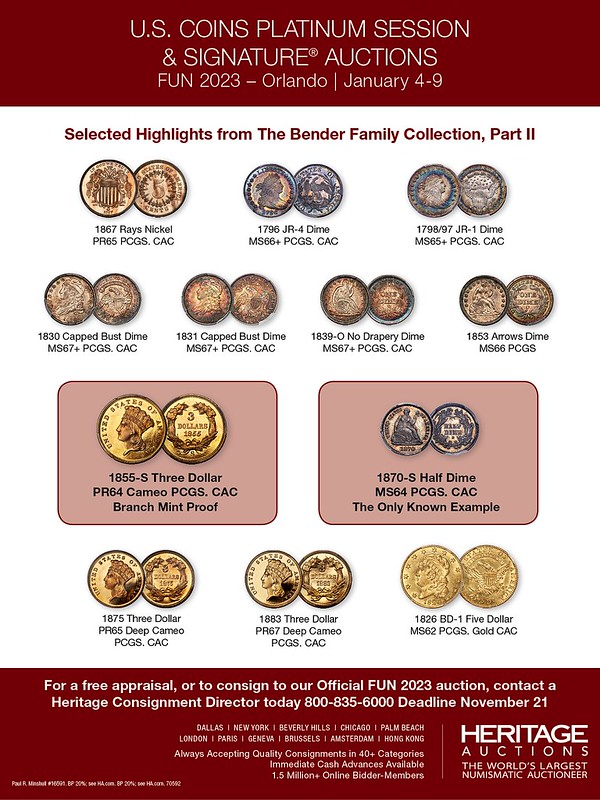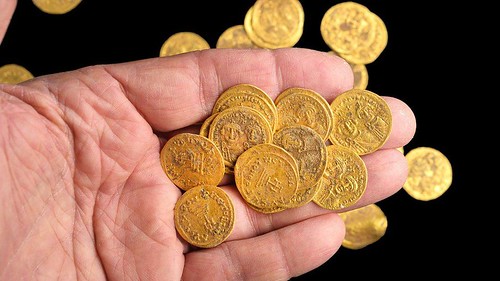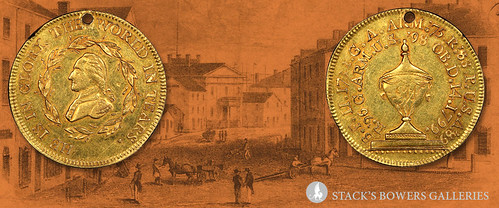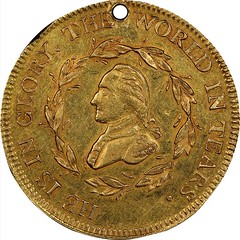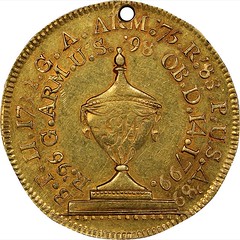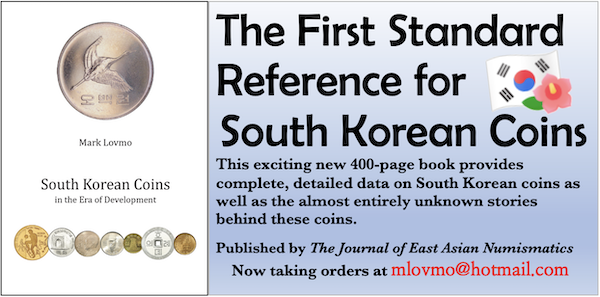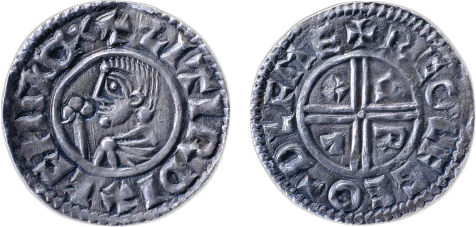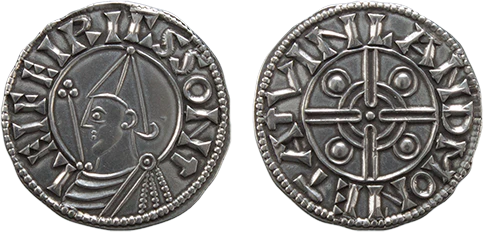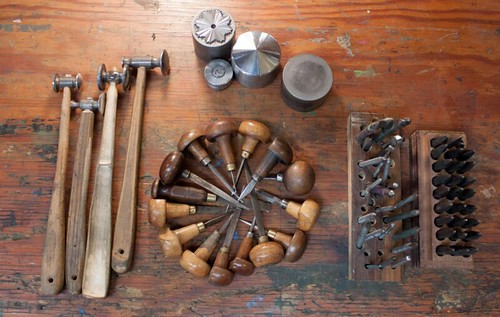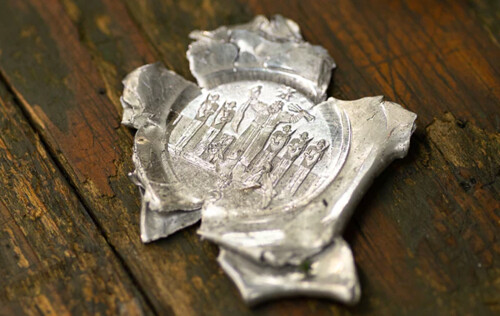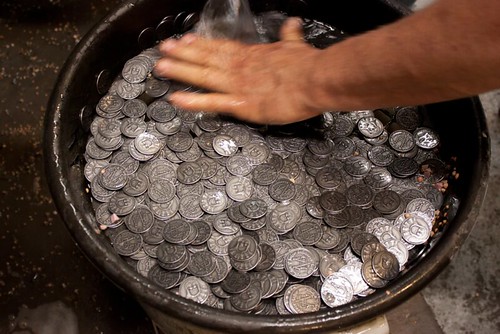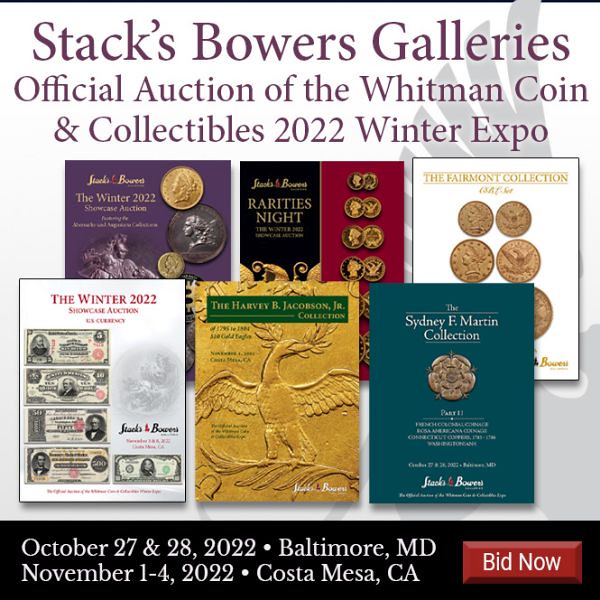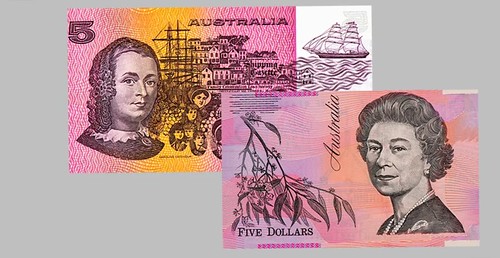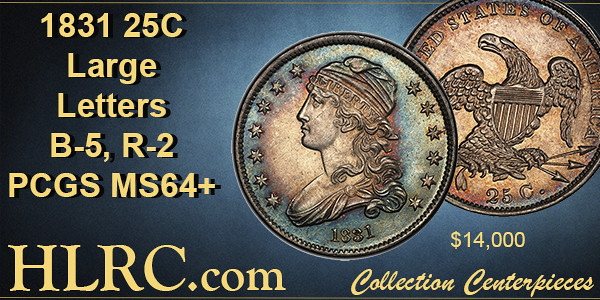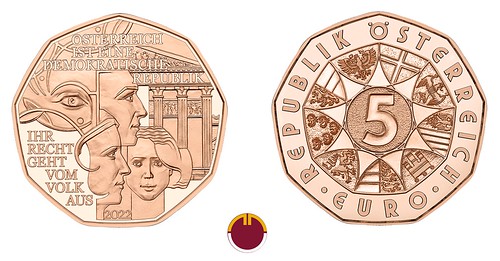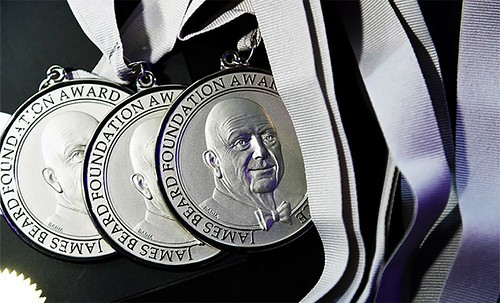
Visit our NBS Sponsors



About UsThe Numismatic Bibliomania Society is a non-profit association devoted to the study and enjoyment of numismatic literature. For more information please see our web site at coinbooks.org SubscriptionsThose wishing to become new E-Sylum subscribers (or wishing to Unsubscribe) can go to the following web page link MembershipThere is a membership application available on the web site Membership Application To join, print the application and return it with your check to the address printed on the application. Print/Digital membership is $40 to addresses in the U.S., and $60 elsewhere. A digital-only membership is available for $25. For those without web access, write to: Charles Heck, Treasurer AsylumFor Asylum mailing address changes and other membership questions, contact Chuck at this email address: treasurer@coinbooks.org SubmissionsTo submit items for publication in The E-Sylum, write to the Editor at this address: whomren@gmail.com BUY THE BOOK BEFORE THE COINSale Calendar |
- WAYNE'S WORDS: THE E-SYLUM OCTOBER 9, 2022
- NEW BOOK: MORGAN SILVER DOLLARS, 7TH EDITION
- NEW BOOK: SCHWAAB STAMP & SEAL OBSOLETE DIES
- NEW BOOK: CANADIAN COLONIAL TOKENS 11TH ED.
- NEW BOOK: COINS AND MINTS IN AVIGNON
- THE MAKING OF THE RED BOOK
- DOES THE CHARLES III COIN BREAK TRADITION?
- KING CHARLES III COIN DESIGNER MARTIN JENNINGS
- NNP ADDS THE EMERGENCY MONEY COLLECTOR
- VIDEO: 2022 SUMMER FUN SHOW WALKABOUT
- VIDEO: INTERVIEW WITH JOHN DANNREUTHER, PART I
- EXHIBIT: DEFACED! MONEY, CONFLICT, PROTEST
- MORE ON DEFACED! MONEY, CONFLICT, PROTEST
- GREETING CARDS OF NUMISMATIC CENTENARIANS
- NOTES FROM E-SYLUM READERS: OCTOBER 9, 2022
- CONNECTICUT DOCUMENTS ON COLONIAL MONEY
- THE NUMISMATIC SIDE OF HURRICANE IAN
- CDN PUBLISHING GLOBETROTS
- VOCABULARY TERM: MARRIAGE MEDAL
- SYLVESTER SAGE CROSBY (1831-1914)
- FALL 2022 PAN CIVIL WAR SHOWCASE
- NUMISMAGRAM MEDAL SELECTIONS: OCTOBER 2022
- COLLECTION OF AN ENGLISH DOCTOR, PART THREE
- DAVISSON'S E-AUCTION 45
- NUMISMATIC NUGGETS: OCTOBER 9, 2022
- BYZANTINE COIN FIND IN ISRAEL
- THE 1930 AUSTRALIAN PENNY
- WASHINGTON FUNERAL URN MEDAL IN GOLD
- THE SHIRE POST MINT
- AUSTRALIA'S WOMEN ON BANKNOTES
- LOOSE CHANGE: OCTOBER 9, 2022
- FEATURED WEBPAGE: JAMES BEARD AWARDS
Click here to read the thin version on the web
Click here to subscribe
Click here to access the complete archive
To comment or submit articles, reply to whomren@gmail.com
Content presented in The E-Sylum is not necessarily researched or independently fact-checked, and views expressed do not necessarily represent those of the Numismatic Bibliomania Society.
WAYNE'S WORDS: THE E-SYLUM OCTOBER 9, 2022
 New subscribers this week include:
Pacifico Diaz-de Rosa, courtesy Adrián González-Salinas;
and Jim Myers. Welcome aboard!
New subscribers this week include:
Pacifico Diaz-de Rosa, courtesy Adrián González-Salinas;
and Jim Myers. Welcome aboard!
Thank you for reading The E-Sylum. If you enjoy it, please send me the email addresses of friends you think may enjoy it as well and I'll send them a subscription. Contact me at whomren@gmail.com anytime regarding your subscription, or questions, comments or suggestions about our content.
This week we open with four new books, the Charles III coins, updates from the Newman Numismatic Portal, a numismatic museum exhibit, and more.
Other topics this week include Morgan dollars, Canadian colonial tokens, Emergency Money, videos, documents relating to U.S. colonial money, marriage medals, Sylvester Sage Crosby, fixed price and auction selections, the 1930 Australian penny, women on Australia's banknotes, and the James Beard award medals.
To learn more about the Schwaab Stamp & Seal Co., coins and mints in Avignon, France, the making of the Red Book, sculptor Martin Jennings, John Dannreuther, Bill Dewey, the Ten Megs fantasy note, greeting cards of numismatic centenarians, cast coinage errors, numismatists dealing with Hurricane Ian, the Maastricht show, Confederate Treasury Notes, the Edouard Manet medal, the the Shire Post Mint, read on. Have a great week, everyone!
Wayne Homren
Editor, The E-Sylum
NEW BOOK: MORGAN SILVER DOLLARS, 7TH EDITION
Dennis Tucker of Whitman Publishing forwarded this information on the new edition of the Morgan dollar Guide Book. Thanks. -Editor
of Q. David Bowers's Guide Book of Morgan Silver Dollars
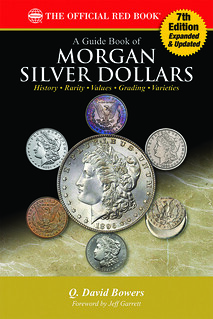 Whitman Publishing will release the newly expanded and updated seventh edition of A Guide Book of Morgan Silver Dollars, by Q. David Bowers, for the 2022 holiday season. The 336-page book will be available in December from booksellers and hobby shops nationwide. In the meantime, it can be preordered (including online at www.Whitman.com).
Whitman Publishing will release the newly expanded and updated seventh edition of A Guide Book of Morgan Silver Dollars, by Q. David Bowers, for the 2022 holiday season. The 336-page book will be available in December from booksellers and hobby shops nationwide. In the meantime, it can be preordered (including online at www.Whitman.com).
The seventh edition's coin-by-coin retail values have been updated in a snapshot of today's rare-coin market, with detailed pricing in 11 circulated and Mint State grades plus 3 levels of Proof. The book includes hundreds of new images, with photographs of every date in the series plus new illustrations in the history chapters and appendices, and galleries of toned silver dollars and error coins. Analysis of certified-coin populations has been updated. The seventh edition includes an updated appendix on counterfeit Morgan dollars, based on the research of Beth Deisher, and a new appendix on the 1921–2021 centennial Morgan dollar coins. The index has been expanded for easy, comprehensive navigation of the book's contents.
Following the format of the first six editions, the seventh includes a history of America's silver dollar dating back to the 1790s, and chapters on the Morgan dollar's design, how dies were made, the minting process, the five mints that struck the coin from 1878 to 1921, and Treasury hoards and other accumulations. For collectors, Bowers gives advice on ways to collect Morgan dollars; grading and the marketplace; and how to cherrypick rare die varieties. The book's year-by-year catalog is an analysis by date and mintmark of more than 100 coins in the series. Appendices offer a report on the recent discovery of 1964 Morgan dollar dies and hubs in the Philadelphia Mint's archives; a study of Morgan dollar patterns; a gallery and descriptions of misstruck and error Morgan dollars (including the 1882-CC Grand Snake
); a study of counterfeit Morgan dollars in today's market; and information on the 1921 Silver Dollar Coin Anniversary Act.
No American numismatic library is complete without the latest edition of A Guide Book of Morgan Silver Dollars,
said Jeff Garrett, senior editor of the Guide Book of United States Coins, in the new edition's foreword.
The cover of the new seventh edition showcases a nearly perfect 1896-S Morgan silver dollar, graded MS-69. Positioned around it are an iridescent toned Proof of 1894; a cropped view of a 1964 Morgan dollar hub; a rare error coin, struck 25 percent off center; a 1921 Chapman Proof,
graded PF-67; a Judd-1371 pattern struck in copper; and a 2021 coin marking the 100th anniversary of the historic Morgan dollar's last coinage.
The Bowers Series, named for Whitman Publishing's numismatic director, Q. David Bowers, is a popular library of numismatic books, each covering a different segment of the hobby. More than two dozen volumes have been published as of 2022, written by Bowers and other authors including David W. Lange, Rick Snow, Katherine Jaeger, Frank J. Colletti, Roger W. Burdette, Rick Tomaska, and Joshua McMorrow-Hernandez. Together they comprise more than 6,000 pages of history, market data, grading instructions, and other valuable numismatic information.
Because Whitman Publishing is the Official Supplier of the American Numismatic Association, ANA members receive 10% off the book when purchasing directly from the publisher. It can also be borrowed for free as a benefit of ANA membership, through the Dwight N. Manley Numismatic Library.
Whitman Publishing author and numismatic director Q. David Bowers and president Mary Burleson at the 2019 American Numismatic Association World's Fair of Money.
A Guide Book of Morgan Silver Dollars, seventh edition
By Q. David Bowers; foreword by Jeff Garrett
ISBN 0794849164 · 6 x 9 inches, softcover, 336 pages, full color · Retail $24.95 U.S.
URL:
https://whitman.com/guide-book-of-morgan-silver-dollars-7th-edition/
NEW BOOK: SCHWAAB STAMP & SEAL OBSOLETE DIES
Tom Casper has published a new book on the dies of the Schwaab Stamp & Seal Co. Congratulations! Here's the announcement. -Editor
Schwaab Stamp & Seal Co - A Catalog of Obsolete Dies
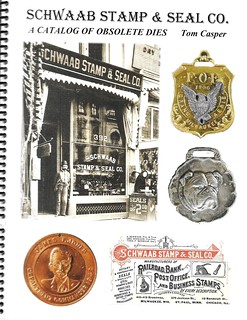 Long time token collector, Tom Casper, has written a book on the Schwaab Stamp & Seal Co. of Milwaukee, WI. The company was a major manufacturer of tokens, medals, and badges. The company was started in 1881 and they produced these pieces until the mid-twentieth century.
Long time token collector, Tom Casper, has written a book on the Schwaab Stamp & Seal Co. of Milwaukee, WI. The company was a major manufacturer of tokens, medals, and badges. The company was started in 1881 and they produced these pieces until the mid-twentieth century.
The book provides a history of the company as well as photos of 800+ Schwaab dies. Some of these dies produced exonumia not seen yet in the marketplace. The dies are in categories of Masonic Tokens, Trade Tokens, Transportation Tokens, Fraternal Organizations, and Miscellaneous Items. The dies struck pieces from 45 different states.
The book is soft cover, 8 1/2" x 11, spiral bound with 95 pages. It contains an alphabetical index for each category. Only a small number of books are available. The book is $29.95 plus $5 shipping and are available from the author at 414-425-5444 or email tcasper57@hotmail.com.
NEW BOOK: CANADIAN COLONIAL TOKENS 11TH ED.
A new edition of the Charlton catalogue of Canadian Colonial Tokens has been published. -Editor
Canadian Colonial tokens, 11th Edition
C. Chapados-Girard, Editor
$43.95
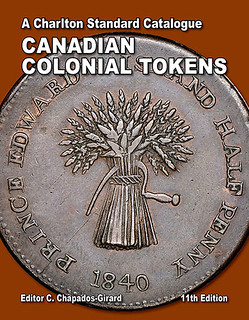 In the 11th edition of the Charlton Standard Catalogue, Canadian Colonial Tokens, nearly 200 pictures have been added or improved. The previous simplification of the reference numbers to keep only the most relevant ones was continued. Many hundreds of minor issues were also improved.
In the 11th edition of the Charlton Standard Catalogue, Canadian Colonial Tokens, nearly 200 pictures have been added or improved. The previous simplification of the reference numbers to keep only the most relevant ones was continued. Many hundreds of minor issues were also improved.
Another major collection has entered the market, namely the Donald G. Partrick Collection, which was offered in two different sales in the spring of 2021. A U. S. based collector, Partrick had an impressive number of rarities. Many of those didn't see other hands than his for half a century. His Blacksmith tokens were particularly impressive and proved very helpful in showing the state of the market last year. Lots of realized prices were noted and some images were improved because of their resurgence through the Partrick Collection.
In the previous edition, Charlton added the Bust & Harp series. This time, they added the Tiffin series. Some extremely rare varieties were also added, and others were noted to make collectors aware of their existence. In the past few years, demand for Colonial tokens has remained strong as more collectors join the hobby.
Format: 7 x 9
Pages: 320
ISBN: 978-0-88968-437-9 (English)
Binding: Spiral, soft cover
Weight .55 kg
Dimensions 23 × 19.5 × 2 cm
For more information, or to order, see:
2023 CHARLTON CANADIAN COLONIAL TOKENS 11TH EDITION
(https://coinstampsupplies.com/product/2023-charlton-canadian-colonial-tokens-11th-edition/)
NEW BOOK: COINS AND MINTS IN AVIGNON
The Society for Numismatic and Archaeological Studies (SÉNA) has published Monnaies et Monnayages en Avignon. The proceedings from a 2017 colloquium are in French. Here is the announcement provided for us by Philippe Schiesser. Thank you. -Editor
Recherches et Travaux de la Société d'Études Numismatiques et Archéologiques (RTSÉNA) 10 : Monnaies et Monnayages en Avignon entre Provence et Papauté.
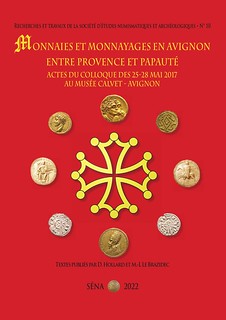 Proceedings of the colloquium of May 25-28, 2017 at the Calvet Museum – Avignon. Research and Works Collection in french of the Society for Numismatic and Archaeological Studies (SÉNA), n°10, Paris, 2022. The new opus of the SÉNA Research and Works collection is now available. This magnificent hardback book made up of 220 color pages in glossy paper contains the papers presented during the colloquium organized jointly by the SÉNA and the GNCP (Groupe Numismatique du Comtat et de Provence) in May 2017 in Avignon (France).
Proceedings of the colloquium of May 25-28, 2017 at the Calvet Museum – Avignon. Research and Works Collection in french of the Society for Numismatic and Archaeological Studies (SÉNA), n°10, Paris, 2022. The new opus of the SÉNA Research and Works collection is now available. This magnificent hardback book made up of 220 color pages in glossy paper contains the papers presented during the colloquium organized jointly by the SÉNA and the GNCP (Groupe Numismatique du Comtat et de Provence) in May 2017 in Avignon (France).
The cover, in the colors of the city of Avignon (yellow and red), represents a Provençal bouletée cross surrounded by coins and medals that you will find studied in this volume. Fifteen articles in french will be presented there, giving pride of place to the collections of the Calvet museum, but also to the Avignon treasure of obols from Marseille, to the Merovingian coins of Arles and Carolingian coins from Uzès, to the Provençal issues of the counts of Toulouse in the Middle Age, or token coins of the Fair of Beaucaire are represented there.
The memory of the late numismatist Pierre-Carlo Vian will remind many numismatists of the various subjects studied by the latter, whether in the Annales du GNCP orin the Gazette provençale. The texts of this RT SENA 10 Avignon are published by Dominique Hollard and Marie-Laure Le Brazidec with the help of Karim Meziane. Marie-Laure Le Brazidec actively participated in this conference as well as in the provision of the museum's collections from the first inventories to the creation of the Calvet Foundation website. We can only encourage readers passionate about Provençal coinage or the study of collections to acquire this latest work from the Research and Works collection of the SENA.
France 35 €, 45 € overseas.
Odile Cavalier : Un trésor de littérature numismatique : le médailler d'Esprit Calvet
Marie-Laure Le Brazidec : Les collections numismatiques conservées au musée Calvet : des réserves au site Internet de la Fondation Calvet
Jean-Louis Charvet : Pierre-Carlo Vian, numismate d'Avignon (1893-1975)
Marie-Laure Le Brazidec : Les publications de Pierre-Carlo Vian dans la presse locale
Jean-Albert Chevillon : Oboles de Marseille : le trésor d'Avignon
Marie-Laure Le Brazidec et Laurent Schmitt : Pentekontadrachma des Theoi Adelphoi conservé au musée Calvet d'Avignon
Marie-Laure Le Brazidec et Laurent Schmitt : Un solidus d'Avitus de l'atelier d'Arles trouvé à Aubenas et conservé au musée Calvet d'Avignon
Marie-Laure Le Brazidec et Laurent Schmitt : Nomisma tétartèron de Théodora conservé au musée Calvet d'Avignon
Philippe Schiesser : Les deniers d'Abbon et de Mauronte frappés à Arles
Philippe Schiesser : Le monnayage d'argent de Charlemagne à Uzès
Vincent Borrel : De Saint-Gilles à Pont-de-Sorgue en passant par Avignon. Les émissions monétaires provençales des comtes de Toulouse du XIe au XIIIe siècle. La Monnaie communale d'Avignon
Jean-Louis Charlet : À propos d'un carlin provençal de Louis de Tarente et Jeanne de Naples
Éric Vandenbossche : Une bourse d'oboles à la crosse d'Arles et de Viviers trouvée dans le département de l'Yonne
Christian Charlet : La glorieuse cité ancienne de Beaucaire sur le Rhône, en Languedoc : sa célébrissime foire multiséculaire et ses monnaies au XVIIe siècle
Cédric Lopez : Intelligence artificielle et numismatique : quid de la représentation des connaissances ?
For more information, or to order, see:
http://senatest.e-monsite.com/pages/nos-publications/la-collection-recherches-et-travaux-de-
la-sena.html
THE MAKING OF THE RED BOOK
In an article published on Coin Update, Dennis Tucker of Whitman Publishing describes the myriad efforts that go into making each year's edition of the Red Book. -Editor
As you read these words, a crack team of more than 100 numismatic experts is hard at work developing the 77th edition of R.S. Yeoman's Guide Book of United States Coins. They hail from every nook of the nation—big cities and small towns, north, south, east, and west—and from every corner and calling within the hobby community. Some are famous coin dealers who buy and sell legendary rarities. Some are major bullion retailers who move millions of dollars of gold and silver. Some focus on rarefied specialties like early copper coins or branch-mint gold pieces. Others sell meat-and-potato collector coins in everyday
grades, Fine to Uncirculated. Some aren't dealers at all, but are active collectors, researchers, and historians.
Each of them has the same goal at heart: To ensure the Red Book,
as the best-selling annual guide is known, remains the most accurate, timely, and useful publication in the hobby, a role it's filled since 1946.
Jeff Garrett, senior editor of the Guide Book of United States Coins, at his Lexington, Kentucky, office,
This summer (late July of 2022), Whitman Publishing held a three-day Red Book Editorial Summit
in the Bluegrass State of Kentucky. Jeff Garrett, senior editor of the Red Book since 2018, hosted Whitman's president, publisher, and senior editor at the Lexington headquarters of Mid-American Rare Coin Galleries. The meeting included an immersive page-by-page study of every aspect of the Red Book in preparation for the 77th edition, which will be released in early 2023, bearing the cover date of 2024.
We've held several of these Red Book Editorial Summits in recent years, mostly in Atlanta,
says Garrett, who became the Red Book's senior editor after longtime editor Kenneth Bressett retired to the position of editor emeritus. (Retired should be put in quotes; Bressett is still active in the book's annual production, reviewing pages and paying particular attention to the colonial sections.)
Garrett's official involvement with the Red Book began as a pricing contributor in 2004, for the 58th edition. He was named the book's valuations editor for the 59th edition and occupied that position through the 71st. Q. David Bowers, the Dean of American Numismatics,
has been the Red Book's research editor since the 59th edition.
This trio is a formidable corps helming the bible of the hobby,
which has sold more than 25 million copies since its 1st edition. But the Red Book is much bigger than a three-man job. At Whitman, a team of in-house editors, associate editors, typesetters, data wranglers, production artists, and project managers keeps the Red Book running smoothly. The aforementioned 100-plus coin dealers, auctioneers, researchers, and other specialists are the engine that powers the book's pricing and numismatic research. Members of the Rittenhouse Society and other numismatic groups are on call to answer questions. And—perhaps most importantly—there are the millions of coin collectors who have bought the annual guide, read it, used it, and rightfully feel that it's their book. They're our honorary editors and advisors, and their involvement is crucial.
Typographical errors in the Red Book are rare, but when one slips in, our faithful readers never fail to spot it! They're also quick to share praise, give feedback on their favorite (or least favorite) sections, offer insight on ways to improve the book, and brainstorm ideas for new features.
The Red Book is truly the hobby's book. If you've collected U.S. coins for 76 years or fewer, the Red Book has always been woven into the fabric of your collecting world. At Whitman Publishing, we give grateful thanks to everyone mentioned above, and especially to you—the coin collector—whether you live in a small town or a big city, and whether you've collected for decades or just started yesterday.
To read the complete article, see:
Notes Published: It takes an entire hobby community to make the Red Book
(https://news.coinupdate.com/notes-published-it-takes-an-entire-hobby-community-to-make-the-red-book/)
DOES THE CHARLES III COIN BREAK TRADITION?
Chip Howell writes:
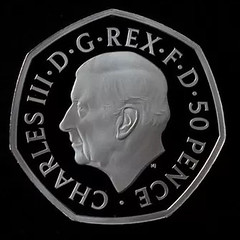 "I wonder if other readers can comment: isn't issuing a 2022 coin w/Charles' effigy a break with tradition? As I understand it, the usual practice is to retain the former monarch's image for the year of his/her death. I had gone so far as to explain this to someone, citing the 20th century examples where the new monarch's coins debuted the NEXT calendar year (Edward VII in 1902; George V in 1911; George VI in 1937; & Elizabeth II in 1953). And yet, within a MONTH of E2's death, we have a C3 coin? Perhaps the Royal Mint is being impetuous or greedy, hoping to cash in ASAP. Perhaps I shouldn't be surprised."
"I wonder if other readers can comment: isn't issuing a 2022 coin w/Charles' effigy a break with tradition? As I understand it, the usual practice is to retain the former monarch's image for the year of his/her death. I had gone so far as to explain this to someone, citing the 20th century examples where the new monarch's coins debuted the NEXT calendar year (Edward VII in 1902; George V in 1911; George VI in 1937; & Elizabeth II in 1953). And yet, within a MONTH of E2's death, we have a C3 coin? Perhaps the Royal Mint is being impetuous or greedy, hoping to cash in ASAP. Perhaps I shouldn't be surprised."
I reached out for comments to readers who'd discussed the coins earlier. -Editor
David Pickup writes:
"As I understand it there is a tradition not to issue coins bearing the new monarch's portrait until after the coronation and this is usually the following year as it takes time to plan. However there are likely to be a new Maundy set issued for next April. Don't forget the new coins are really commemorative coins and are unlikely to be put in circulation. One is a 50 pence coin which will probably be sold as a commemorative in special display packs, proofs and bullion issues.
"I agree the Royal Mint will want to sell items to the public for Christmas. However that is a part of the Royal Mint's role to make a profit and mark public events.
"I hope that they will use the opportunity to re-design the reverse images. The current designs are very good but new reign should mean new designs."
Martin Purdy of New Zealand had these thoughts. -Editor
"I guess there are three factors at play here: necessity, technology, and politics, rather than just a desire for profit:
"Necessity: I'm only guessing, but I assume on previous occasions there have been plenty of coins already in circulation, or a new issue for the year with the "old" monarch's effigy already planned or in production, so there has been no need to rush into production with the new effigy. We have that in NZ at the moment, with plenty of coins already in stock in our central bank, so there is no hurry to get coins with King Charles' effigy produced and out in circulation (there's some lobbying for us to do there!). The same applied in 1952, as I understand it. There was no coin shortage but a full run was made in 1953 for the occasion, and then some denominations weren't struck again until 1961!
"As for British coins, I have a shilling of George II dated 1727, his year of accession, his father having died in June that year, and guineas were struck for George I in 1714, for example, so it has been done in the past. A quick glance at the catalogue shows there are halfcrowns of George IV dated 1820, and various denominations issued under Anne in 1702 and James II in 1685, etc. Admittedly I had to go back quite a way for examples. Perhaps the need to get coins in circulation - which Britain lost sight of entirely for much of the 18th century - encouraged the Mint to get a move on in those years at least.
Of course, since the Queen died in September, coins dated 2022 bearing her effigy had already been produced for the UK, so the image has indeed been "retained" for the year in that sense.
"Technology: With digital systems and even advances in photography it's probably a much faster process now to get a die ready with the monarch's image. In 1936, Edward VIII abdicated before the year was out, but colonial coins bearing his name but no effigy were released with that date in Fiji, New Guinea and a handful of locations in Africa and India; as we know, portrait coins had been prepared in Britain during the year (in 1936 they at least had time from January to make a start) but weren't expecting to release them until the following year and so they were dated accordingly. The few 1937-dated nickel-brass threepence coins that were provided to machine makers for calibration, one or two of which accidentally slipped into circulation, must have been made before the end of the year.
"Politics: I make no secret of being something of a Charles fan, but acknowledge he has a few PR matters to deal with, and so - not unlike the practice of rushing coins into circulation in ancient times as soon as a new Emperor was proclaimed - it's probably no bad thing to get coins with the new effigy in people's pockets sooner rather than later."
Alan Luedeking passed along another article about the coins. Thanks, everyone! Also, see the following article in this issue about the designer of the coins, sculptor Martin Jennings. -Editor
To read the complete article, see:
The U.K. Royal Mint Has Unveiled Coins of the Newly Crowned King Charles III, Designed by Sculptor Martin Jennings
(https://news.artnet.com/art-world/king-charles-mint-coin-2184321)
To read the earlier E-Sylum article, see:
KING CHARLES III COIN DESIGNS REVEALED
(https://www.coinbooks.org/v25/esylum_v25n40a25.html)
KING CHARLES III COIN DESIGNER MARTIN JENNINGS
This article from The Canberra Times provides some information on sculptor Martin Jennings, designer of the new coinage portrait of King Charles III. -Editor
Less than a month after the death of Queen Elizabeth II, the first coins featuring the official portrait of King Charles III have been released.
Each of the new commemorative coins bears the first coinage portrait of the King, designed by British sculptor Martin Jennings and personally approved by King Charles III.
"I was delighted to hear that the King likes the image," Mr Jennings told the Royal Mint.
"He was very interested in it and responded very positively to it."
To prepare for the process of designing His Majesty's official coinage portrait, Mr Jennings began his research by studying as many photographs of The King as he could.
"You collect as many photographic images of your subject as you can," he said.
"To present just one side of somebody's head, you have to understand how the head works in the round, so you examine all of these old photographs then settle on just one or two that give you the optimal impression of the side of the head that you are modelling.
"The piece is modelled in plaster larger than the size of the coin, so about the size of a dinner plate.
"I work by hand using tiny, tiny millimetres of material to model it. And eventually, once it is complete and cast in plaster, my original design can be digitally reduced so that the impression is the right size for a coin."
To read the complete article, see:
King Charles III coins released by the Royal Mint
(https://www.canberratimes.com.au/story/7927207/how-to-get-your-hands-on-a-newly-minted-king-charles-iii-coin/)
NNP ADDS THE EMERGENCY MONEY COLLECTOR
The latest addition to the Newman Numismatic Portal is The Emergency Money Collector. Project Coordinator Len Augsburger provided the following report. Thanks. Great little publication. -Editor
Newman Portal Adds The Emergency Money Collector
Produced by Arlie Slabaugh shortly after World War II, The Emergency Money Collector sought to gather information on the host of emergency issues that were created in response to the war effort. The modest periodical featured Slabaugh's lists of known items, in addition to related dealer advertisements. Volume I (1948-1949) was commercially printed, and, after a gap of several years, Slabaugh resorted to the mimeograph for Volume II (1953). Slabaugh explains in the summer 1953 issue ‘The Emergency Money Collector' has been erratic in publication and this I much regret. The fault lies mainly with the printing.
Numismatists constantly try to restore order to the chaos, and this journal represents one of the first attempts to document all of the World War II issues in one place. Today, this field is of course thoroughly treated by Joe Boling and Fred Schwan in World War II Remembered, a massive labor of love that is clearly the standard reference on the subject. Thanks to Clifford Mishler, who loaned these periodicals to Newman Portal for scanning.
Link to The Emergency Money Collector on Newman Portal:
https://nnp.wustl.edu/library/publisherdetail/547740
VIDEO: 2022 SUMMER FUN SHOW WALKABOUT
These are selections from the David Lisot Video Library that feature news and personalities from the world of coin collecting. David has been attending coin conventions since 1972 and began videotaping in 1985. The Newman Numismatic Portal now lists all David's videos on their website at:
https://nnp.wustl.edu/library/multimediadetail/522852
Here's one on the 2022 Summer FUN show. -Editor
Amazing Numismatic Walkabout at FUN Summer 2022 with David Lisot.
David Lisot, Host, CoinTelevision.com with Mike Bean, Bob Hurst, Lisa Venas, Dylan & Madison Wexler, Katie Williams, & Abigail Zechman.
The Florida United Numismatists Summer Convention is not as large at the January convention, but it still has a lot to offer. David Lisot takes you on another Numismatic. Walkabout showing some of what Summer FUN 2022 has to offer. The video begins with the FUN Opening Ceremony with President Bob Hurst. The David speaks with Abigail Zechman and Katie Williams, two new personalities with the FUN organization. The walkabout includes the Spider Press, young numismatists and pages, a new Spanish language YouTube channel, and more! [22:26 minutes]
David adds:
"Attending the Florida United Numismatists Convention is always an adventure. It is one of the most well-run coin shows in America. The convention planners always have a plethora of fun and educational exhibit for collectors. Plus, they treat the dealers well. If you have not been to a FUN Convention you might want to make plans for the next one!!"
An excerpt of the video is available for viewing on the Coin Television YouTube Channel at:
https://youtu.be/imP52Eb3PNs
VIDEO: INTERVIEW WITH JOHN DANNREUTHER, PART I
In his latest YouTube video, Ron Guth interviews numismatic industry legend John Dannreuther. -Editor
This is the first part of an interview with John Dannreuther, a rather famous numismatist known to his friends and colleagues simply as JD. I've known JD since the late 1970's and he is one of the most respected dealers in the coin industry, not only for his incredible research and the books he has published but also because he is a genuinely nice guy. He is very approachable, he loves to share his knowledge, and he is full of stories from his decades in the business. This interview started out as a test of the Zoom technology but turned into an actual interview, so it is completely natural... no prompts, no prepared questions, just two old friends talking, me mostly listening, and JD sharing his stories. In the past, JD and I have talked for hours, so you can bet there will be later episodes with more great information. Please sit back and enjoy.
To watch the complete video, see:
Ron Guth on Coins 17 - An Interview with John Dannreuther, Part I
(https://www.youtube.com/watch?v=yXmgJJT35k8)
EXHIBIT: DEFACED! MONEY, CONFLICT, PROTEST
The Fitzwilliam Museum in Cambridge is about to open an extensive new exhibit of coins, banknotes and money art of protest. Here's the press release, -Editor
Mark Wagner, artist (b. 1976)
Defaced! Money, Conflict, Protest (11 October – 8 January 2023) is the first major exhibition to present a world history of protest through currencies that have been mutilated as cries of anger, injustice, or despair from the last 250 years. Defaced! showcases a new collection of defaced coins and banknotes recently acquired for the Fitzwilliam by its curator Dr Richard Kelleher, complemented by important loans from private collections and museums.
Punched, scratched, over-printed or digitally manipulated, there are many reasons people have decided to ‘take it out on money'. With their idealised portraits of leaders, emblems of national identity, and heavily policed production, currencies represent state authority in hand-held form. For artists and the individual alike, money's iconic imagery makes it a potent readily available medium to address issues of social, political, and racial justice.
The acts of defacement on show reveal the hidden struggles behind some of the major events of the past 250 years, as disparate as the French and American Revolutions, the suffragette movement, the Siege of Mafeking, the Spanish Civil War, the Nazi concentration camp system and occupation, the deadly sectarian Troubles in Northern Ireland, and the Black Lives Matter protests.
In 1819, George Cruikshank made the Bank Restriction Note as a challenge to the draconian punishments meted out on those caught using, or even possessing, forged banknotes. Cruikshank altered the traditional iconography of the note, converting it into the images of state violence - skulls, a hangman's noose, ships for transportation – penalties that were dealt to those who dared counterfeit paper money and disturb the fragile social promise upon which it was based.
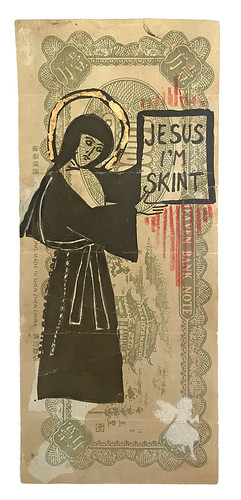 Defaced currencies continued to condemn and question the
establishment for the next 200 years. Engraved and mutilated coins
throughout the exhibition rage at figures of power. George III, the
Pope, and Prime Minister William Pitt all appear on the gallows,
while other defacements are more satirical. George IV is converted
into ‘the patron of vice and frivolity', William IV is ‘the Idiot King',
and Queen Victoria has ‘shag for ever' engraved across her image.
Defaced currencies continued to condemn and question the
establishment for the next 200 years. Engraved and mutilated coins
throughout the exhibition rage at figures of power. George III, the
Pope, and Prime Minister William Pitt all appear on the gallows,
while other defacements are more satirical. George IV is converted
into ‘the patron of vice and frivolity', William IV is ‘the Idiot King',
and Queen Victoria has ‘shag for ever' engraved across her image.
From Thomas Spence's call for the abolition of landlords, to the
pennies laboriously defaced by the Suffragettes in the early 20th
century, which saw the cry Votes for Women
being circulated on
currency itself, to the present-day campaign of stamped US $20
bills featuring the portrait of Harriet Tubman, money has been used
to publicise campaigns for change and equality to the present day.
Money is the perfect medium to highlight issues of wealth distribution, including the chasm between those at the top and the bottom, and the effects on those living in poverty. It has been used by artists to draw attention to the links between government policy and the financial and banking systems.
A room devoted to the theme of poverty and wealth inequality forms a hinge-point to the exhibition with the spectacular loan of the fragments of an exploded transit van detonated by the HSCB (Hoe Street Central Bank) as part of the Big Bang 2 project which bought up £1.2m of payday loan debt in Walthamstow, London. Ben Oakley's Jesus I'm Skint uses an icon-like religious figure in a pastiche of Roman Catholic kitsch.
Currencies invented for use in policed, occupied, or besieged spaces were weapons of propaganda, control and a source of resistance. The Nazi POW and concentration camp systems used camp money as illusory incentives, while the Oranienburg-Sachenhausen concentration camp was notorious for ‘Operation Bernhard', the largest counterfeiting operation of all time intended to undermine the British economy. The fake banknotes, valued somewhere between £100,000,000 and £300,000,000, were produced by inmates, many of whom were highly skilled artists, engravers, and typographers.
The stamping and counter-stamping of coins by opposing Fascist and Communist sides in the Spanish Civil War and by Loyalists and Republican Nationalists in Northern Ireland in the 1970s and 1980s, illustrate the ways that messaging on money was used as a form of intimidation, provocation and declaring allegiance.
Harry of England/Ten Megs fantasy note, Meghan Markle appears next to her father with the message ‘Trust No Press' © Boo Whorlow.
In the 21st century, politicians and other authority figures have remained a popular target for defacement. The satirist known as Wefail applies his famously grotesque caricature style to Tony Blair in ‘It's Complicated' (2019), a specially commissioned physical version of his £10 note print which satirises Blair's explanation for Britain's involvement in the Iraq War. Harry of England/Ten Megs (2019) is a next generation reworking of Banksy's influential Di-Faced tenner in which Prince Harry replaces Queen Elizabeth II and Meghan Markle appears on the reverse with the message ‘Trust No Press'. The controversy around Donald Trump's wall on the US-Mexican border, and his administration's alleged links to Vladimir Putin, are subjects of Sean Kushner's trademark colourful satire on a US dollar.
Against the backdrop of our current cost of living crisis, times of inflation, spiralling costs and debt, the exhibition's themes in which currency has been, and continues to be, created and defaced in protest remain urgently relevant.
#Defaced! |11 October 2022 - 8 January 2023 | Admission Free
An illustrated exhibition catalogue, Defaced! Money, Conflict, Protest, edited by Dr Richard Kelleher, will be published by Paul Holberton Publishing in October 2022.
The Fitzwilliam Museum is grateful to the support of the Art Fund for their New Collecting Awards programme, which invests in the development of some of the UK's rising curators. The award enabled Dr Richard Kelleher to acquire a new collection of currencies for the museum which are on show in this exhibition.
The Fitzwilliam Museum
Founded in 1816, the Fitzwilliam Museum is the principal museum of the University of Cambridge and
lead partner for the University of Cambridge Museums (UCM) Arts Council England National Portfolio
Organisation funded programme. It houses over half a million objects from ancient Egyptian, Greek and
Roman artefacts, to medieval illuminated manuscripts, paintings from the Renaissance to the 21st
century, world class prints and drawings, and outstanding collections of coins, Asian arts, ceramics and
other applied arts. The Fitzwilliam is an internationally recognised institute of learning, research and
conservation.
Here are some additional images. The last item is a large-scale work by Money Artist J.S.G. Boggs. -Editor
For more information, see:
Defaced! Money, Conflict, Protest
(https://www.fitzmuseum.cam.ac.uk/visit-us/exhibitions/defaced-money-conflict-protest)
MORE ON DEFACED! MONEY, CONFLICT, PROTEST
There are more great images of the Defaced! exhibit in this article from the Largs & Millport Weekly News. -Editor
An exhibition of defaced money mutilated as cries of anger, injustice or despair
is to go on display, including a banknote featuring the Duke and Duchess of Sussex.
Cambridge's Fitzwilliam Museum will host the exhibition called Defaced! Money, Conflict, Protest from Tuesday.
It has been billed by the museum as the first major exhibition to present a world history of protest through currencies that have been mutilated as cries of anger, injustice or despair from the last 250 years
.
Harry and Meghan appear in a 2019 work by Boo Whorlow called Harry of England/Ten Megs, a reworking of Banksy's Di-Faced Tenner which featured Diana, Princess of Wales.
In the work, the duke replaces the Queen and Meghan appears on the reverse with the message Trust No Press
.
Artist Sean Kushner created a satire featuring Donald Trump on a colourful one dollar banknote saying Maybe bae will buy me a wall
, with a smaller illustration of Russian President Vladimir Putin next to him, hinting at the alleged links between the two.
The Fitzwilliam Museum said: Money is the perfect medium to highlight issues of wealth distribution, including the chasm between those at the top and the bottom, and the effects on those living in poverty.
It has been used by artists to draw attention to the links between government policy and the financial and banking systems.
Against the backdrop of our current cost-of-living crisis, times of inflation, spiralling costs and debt, the exhibition's themes in which currency has been, and continues to be, created and defaced in protest remain urgently relevant.
– The exhibition will run from October 11 to January 8 and admission will be free.
To read the complete article, see:
Exhibition of defaced money to include Harry and Meghan banknotes
(https://www.largsandmillportnews.com/news/national/23030629.exhibition-defaced-money-include-harry-meghan-banknotes/)
GREETING CARDS OF NUMISMATIC CENTENARIANS
David Glatfelter submitted these great notes and images on the greeting cards of numismatic centenarians. Thanks! May you live long and prosper! -Editor
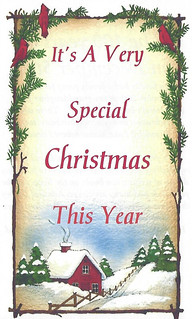 William S. Dewey, 1905-2006: Bill celebrated his 100th birthday on December 5, 2005, and a few days before that sent out this
William S. Dewey, 1905-2006: Bill celebrated his 100th birthday on December 5, 2005, and a few days before that sent out this very special
Christmas card. He actually celebrated his 101st Christmas that year, doubtless forgetting the 1905 Christmas when he was only a few days old (that was the year that he WAS the Christmas present although he might have received a few of his own). Bill was the ANA's first librarian and served in other jobs too, including but not limited to preparation of the 1940 index to The Numismatist. He was a supervising engineer for the New York Telephone Company, volunteer chairman of his local water and sewer authority after he retired, and founder and president of several local coin clubs. The Ocean County Historical Society published two of his studies on local industries (the Bergen Iron Works and the Torrey brothers' railroad construction business, both of which issued exonumia). He wrote frequent stories on historical and numismatic topics, one together with me. He received the Krause Numismatic Ambassador award in 1987.
Eric P. Newman, 1911-2017: Over his long life Eric published many research studies on numismatic topics, all set forth in an extensive annotated bibliography in Truth Seeker (see below). But perhaps his greatest contribution to the discipline was establishing the not-for-profit Eric P. Newman Numismatic Education Society (EPNNES), largely funded by the sale of his extensive collections of coins, paper money and numismatic literature. He also established the Newman Numismatic Portal (NNP) maintained at Washington University in St Louis, which makes available, free of charge, an eclectic, in-depth selection of numismatic literature to scholars and novices alike. The story of Eric the humanist and humanitarian is chronicled in Truth Seeker: The Life of Eric P. Newman by Leonard Augsburger (currently the NNP project coordinator), Roger W. Burdette and Joel Orosz (Dallas: Ivy Press, Inc., 2015). The greeting card for Eric's 106th birthday in 2017 was designed by friends and collaborators Maureen and Stuart Levine. Needless to say, Eric loved it, and you will too.
To read the earlier E-Sylum articles, see:
ARTHUR HENRY FRAZIER (1899-2000)
(https://www.coinbooks.org/v25/esylum_v25n39a14.html)
NOTES FROM E-SYLUM READERS: OCTOBER 2, 2022 :
On the Beginning and End of Centuries
(https://www.coinbooks.org/v25/club_nbs_esylum_v25n40.html)
NOTES FROM E-SYLUM READERS: OCTOBER 9, 2022
On Photoshop As an Analytical Tool
Bill Eckberg writes:
"I found Bob Van Arsdell's piece on the breakage of a die very interesting and clearly described. I wonder, however, why he refers to his coin as the penultimate
coin struck, as it shows the second die break, and so probably no further coins were struck from that die. That would make it the ultimate coin of the variety. I guess I'm just not clear on that point.
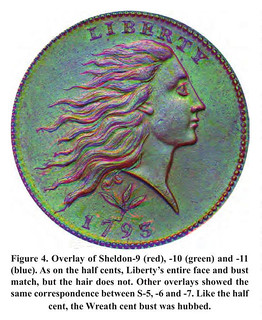 "I would add that Photoshop editing has been a useful tool for numismatic research for several years. Back in 2017, I used Photoshop overlays to demonstrate that the 1792 disme and 1793 half cent dies were produced from the same obverse head punch (or hub, if you prefer). That article was published in The Numismatist, June, 2017, pp. 52-54. I have since used the method to analyze how many of the early US Mint dies were made, including demonstrating that the Wreath cent obverses were ALSO produced from a hub.
"I would add that Photoshop editing has been a useful tool for numismatic research for several years. Back in 2017, I used Photoshop overlays to demonstrate that the 1792 disme and 1793 half cent dies were produced from the same obverse head punch (or hub, if you prefer). That article was published in The Numismatist, June, 2017, pp. 52-54. I have since used the method to analyze how many of the early US Mint dies were made, including demonstrating that the Wreath cent obverses were ALSO produced from a hub.
"This last is an important finding; we've all been taught that the Wreath cent came about because of popular hostility to the Chain cent design, but that was not the case. The design change actually came about because of a new method of die manufacture that was introduced. All Chain dies had been individually engraved, and it took longer to engrave an obverse than the die would last in coinage. Thus, if a reasonable number of coins were ever going to be produced, obverses had to be hubbed."
"Penultimate" means the next-to-last in a series. I reached out to Bob Van Arsdell for comment. -Editor
Bob writes:
"Yes, my coin is the ultimate
coin. The penultimate
coin is the Photoshop simulation. The penultimate coin no longer exists."
To read Bill's April 2017 Penny-Wise article on the topic, see:
Hubbed 1793 Obverse Dies
(https://nnp.wustl.edu/library/book/573707)
To read the earlier E-Sylum article, see:
NOTES FROM E-SYLUM READERS: OCTOBER 2, 2022 : Witness Marks and the Death of a Die
(https://www.coinbooks.org/v25/esylum_v25n40a13.html)
Cast Coinage Errors
Ted Puls submitted these notes and images about cast coinage errors. Thanks! -Editor
"I thought I might add to the piece about forgotten ancient errors. A doubly forgotten error area is cast coinage errors. Attached are some quick photos of a few. Hou Quan ca.14-23 A.D. I think this explains why the early"money spring" coinage rapidly shrank from 30 grams to two grams due to the casting material being unable to handle the molten metal mass.
The second is an example of an extremely rare Hou Quan that was made with a core of iron which shows that this minting idea interfered with the metal flow. Another idea was quickly abandoned.
The third is a common Wu Zhu of the Western Han era ca. 118-0 B.C. The vertical style of the mold rather than the usual bar-like mold leaked between stacked layers causing this error.
Finally, a Dong Zhou Wu Zhu ca 198 A.D. shows a bit of retained metal in the coins minute millimeter sprue. This indicates that even 0.4 grams of metal when poor workmanship is used, can still lead to error. Other types of error exist but not these are not for today."
To read the earlier E-Sylum article, see:
THE ORIGINAL ERROR COINS
(https://www.coinbooks.org/v25/esylum_v25n40a22.html)
Coins Picturing the Silphion Plant
UK reader Glen Wilson writes:
"I thought our readers might find this article interesting.
 "A silver tetradrachm and gold drachm minted in the 4th century B.C. in Cyrene (modern Libya) feature the image of the silphion plant. Cyrene was famed as the source of ancient silphion, and coins bearing its image, like these now in the American Numismatic Society collections in New York City, have been found across the ancient Mediterranean world and Asia."
"A silver tetradrachm and gold drachm minted in the 4th century B.C. in Cyrene (modern Libya) feature the image of the silphion plant. Cyrene was famed as the source of ancient silphion, and coins bearing its image, like these now in the American Numismatic Society collections in New York City, have been found across the ancient Mediterranean world and Asia."
I have read about this "extinct" plant, Silphion, used by the Romans & others a few times over the last few years but it now looks like they may have found some living examples in Turkey.
It has been partly identified by the images on these coins and the speed of growth as well as by cooking know recipes and comparing it with the less good replacements, sounds fairly convincing."
Thank you. I was unaware of the plant or coins. Interesting. -Editor
To read the complete article, see:
This miracle plant was eaten into extinction 2,000 years ago—or was it?
(https://www.nationalgeographic.com/history/article/miracle-plant-eaten-extinction-2000-years-ago-silphion)
Bidding in the Peter Tillou Sale
Hedley Betts writes:
"In the latest E-Sylum, you mentioned the Peter Tillou sale and asked if anyone bid in it. I did. I bid on all the lots of numismatic books. I won one lot, a group of world numismatic books, which included Van Meiris three volume work on Dutch medals. I believe I was the underbidder on the others. The sale also included several lots of medals, which sold for significantly more than their estimates. I bid on most them, but only won one lot."
Congratulations on your purchase! -Editor
To read the earlier E-Sylum article, see:
PETER H. TILLOU NUMISMATIC LITERATURE SALE
(https://www.coinbooks.org/v25/esylum_v25n40a04.html)
State of California $20 Pattern
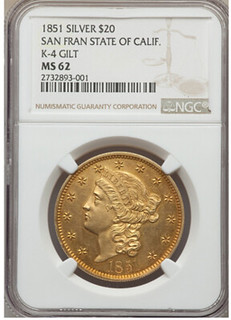 "I am trying to research the history of a very specific 1851 State of California $20 Gilt without much luck and am wondering if your readers might be able to help me out.
"I am trying to research the history of a very specific 1851 State of California $20 Gilt without much luck and am wondering if your readers might be able to help me out.
"This particular 1851 State of California K-4 is apparently unique in Gilt.
"It has appeared in two recent Heritage auctions, in 2018 and 2020 but I can find no information on it prior to 2018. I have contacted NGC and the NGC forums without any luck and am not sure on how to proceed from here.
"I am wondering if any of your readers might recognize this unique coin and help to shed some light on its history.
"I would also like to get an opinion on the age of the gilting as well."
Interesting piece - can anyone help? -Editor
To read the complete Heritage lot descriptions, see:
1851 P$20 San Francisco State of California 20 Dollars Pattern, MS62 Gilt NGC. K-4, Low R.7....
(https://coins.ha.com/itm/territorial-gold/territorial-and-fractional-gold/1851-p-20-san-francisco-state-of-california-20-dollars-pattern-ms62-gilt-ngc-k-4-low-r7-pcgs-10369-/a/1271-5218.s)
1851 P$20 San Francisco State of California 20 Dollars Pattern, MS62 Gilt NGC. K-4, Low R.7....
(https://coins.ha.com/itm/territorial-gold/territorial-and-fractional-gold/1851-p-20-san-francisco-state-of-california-20-dollars-pattern-ms62-gilt-ngc-k-4-low-r7-pcgs-10369-/a/1316-3328.s)
More on A.I. in Coin Designs
Edwin Johnston writes:
"Interesting to see your piece on artificial intelligence-generated coin subjects. My use of A.I. in coin designs has been referred to here previously, and I keep up with the technology so here are some recent entries from the DALL-E website for your edification."
Thanks. Check out Edwin's earlier designs in the previous article, linked below. -Editor
To read the earlier E-Sylum articles, see:
DALL-E COIN IMAGES
(https://www.coinbooks.org/v25/esylum_v25n40a14.html)
EDWIN JOHNSTON'S AI MONEY ART DESIGNS
(https://www.coinbooks.org/v23/esylum_v23n42a17.html)
THE BOOK BAZARRE
CONNECTICUT DOCUMENTS ON COLONIAL MONEY
Craig Sholley reports an amazing find of Connecticut documents relating to colonial era coins and paper money. -Editor
A few weeks ago, fellow EACer Henry Hettger contacted me on behalf of another EACer, Jim Myers, who had purchased a group of historical documents which included some from the state of Connecticut. Jim, who was seeking documents related to family history, purchased them in an on-line auction for less than a hundred dollars. While he did not find any records of family significance, three Connecticut state documents caught his attention.
The state documents are signed by George Wyllys, the Secretary of the General Assembly of
the State of Connecticut. Since each document contains the phase A true Copy of Record
Examind By
followed by Wyllys' signature, they are apparently the handwritten copies of the
legislative record sent out for printing into public notices.
The first document, dated November 29, 1780, instructs tax collectors to turn in to the state
treasury any Continental Bills
they had received or would receive in the future. The other two
documents, dated December 29, 1790 and May 2, 1791, authorize the sale of copper coins in
the state treasury. All three documents are obviously genuine. Not only does Wyllys' signature
match his signature on Connecticut state notes, but the May 2, 1791 document has a very clear
watermark of the Connecticut state seal.
Talk about a fantastic find; I was pretty much floored. While I've handled thousands of such documents in state, federal, and museum archives, I don't recall ever seeing documents with such direct numismatic connection in private hands. I told Jim he had documents collectors would love to own and that would form the core of a really interesting collection.
Jim is now pursuing a collection with the documents as centerpieces. I suggested that he display the documents and the collection he forms around them once he has enough to make a reasonable presentation. Hopefully, we'll see them in the near future.
So, how did these documents come into the public domain? Erik Goldstein, Senior Curator of Mechanical Arts & Numismatics with The Colonial Williamsburg Foundation, noted that in the 1970 the Connecticut state archives tossed out (!) most of their 18 th century paper documents after microfilming it and that a friend had rescued much of it from the dumpster. Perhaps these documents came from that haul.
At a general Assembly of the Govt & Company of the State of Connecticut holden at Hartford by special Order of his Excellency the Gov, on the 29th day of Nov 1780
Resolved by this Assembly that the Several Collectors be and they are hereby directed to pay into the Treasury all the old Continental Bills they have heretofore collected and now have on hand, or shall hereafter receive upon any of the Taxes laid by the General Assembly of this State -
A true Copy of Record
Examind
By George Wyllys Surell (or Surels?)
State of Connecticut
At a general Assembly of the State of Connecticut holden at New Haven by Assignment on the 29th Day of Decembr. 1790
Resolved by this Assembly that the Treasurer be and is hereby Authorized and Directed to sell and dispose of the Copper Coin in the Treasury of this State for the Liquidated Notes or Securities of this State provided he can obtain two shillings in said Notes or Securities pr pound Weight for said Coppers -
A true Copy of Record
Examind
By George Wyllys Surell (or Surels?)
At a general Assembly of the State of Connecticut holden at Hartford on the 2d Thursday of May, Anno Dom. 1791 -
Resolved by this Assembly, that the Treasurer be and is hereby authorized and directed to dispose of the Coppers, now in the Treasury, and the Property of this State, to the best Advantage, And report make of his Proceedings in said Business
A true Copy of Record
Examind
By George Wyllys Surell (or Surels?)
THE NUMISMATIC SIDE OF HURRICANE IAN
Larry Jewett of Coin World published an article about numismatists dealing with the aftermath of Hurricane Ian. Here's an excerpt - see the complete article online. -Editor
 As the storm moved closer, the trajectory began to change. Soon it appeared Tampa would be spared, and that the likely point of landfall would be the Bradenton-Sarasota area, south of Tampa. Preparations ramped up in that region. Certified Collectibles Group, which includes Numismatic Guaranty Co. and Paper Money Guaranty among others, based in Lakewood Ranch, announced closure on Tuesday afternoon with precautions in place.
As the storm moved closer, the trajectory began to change. Soon it appeared Tampa would be spared, and that the likely point of landfall would be the Bradenton-Sarasota area, south of Tampa. Preparations ramped up in that region. Certified Collectibles Group, which includes Numismatic Guaranty Co. and Paper Money Guaranty among others, based in Lakewood Ranch, announced closure on Tuesday afternoon with precautions in place.
Still, the storm drifted eastward, striking Florida on Wednesday, Sept. 28, at Cayo Costa Island as a Category 4 hurricane, tied for the fourth-largest storm to strike the United States. Packing winds of greater than 150 miles per hour, it blew onto the coast of Florida, through Fort Myers and Cape Coral, sweeping up the spine of the peninsula and dumping dozens of inches of rain on the land, ominously arriving at high tide.
It got nasty, the water was like a tsunami,
said Mike Joyce of Gulfcoast Coin & Jewelry in Fort Myers and Bonita Springs, among the businesses directly hit by the storm. It was so fast and violent when it arrived. There are areas where the roofs are torn off. The store may have 15 holes in the roof. It's a bad situation, but we're all OK. Many people were not. It's going to take a long time to be done and get things back into shape.
People are working together. When you approach a major intersection, there's no power, the traffic signals aren't working, but people are courteous to each other and being patient and kind.
North of the scene in Bradenton, John Maben said his shop, Pegasus Coin and Jewelry, was spared. At my home, there were a dozen 50- to 60-foot trees that fell. We had closed the business for a day and a half because of the storm, but were able to open back up, with the worst of it on Wednesday.
Certified Collectibles Group was able to reopen for business as usual on Monday, Oct. 3.
Bob Merchant is an E-Sylum reader and regular eBay seller of merchant counterstamps that are often featured here. Last Sunday he reported "I am in the middle of a hurricane recovery zone at the moment (near Fort Myers, Florida). No power, water, etc. I will ship all coins as soon as the power is restored and the USPS post offices reopen. " -Editor
On Wednesday Bob added:
"Still no power, but we now have water. Nearly all of the vehicles in my development were underwater and declared totaled by the insurance companies, including mine. Several condos had water flowing in from outside. It's a real mess. Port Charlotte also got flooded. The water was 8 feet deep where I was staying. Thick mud everywhere now. I've installed several generators, pressure-sprayed all day today. The cleanup will continue for quite a while."
Today Bob added:
"We had power restored late yesterday (10/8, after 10 days). 100+ vehicles in the development where I am staying were flooded, towed (or soon will be), and declared totaled by the insurance companies. I'm guessing at least several thousand vehicles were flooded area-wide. Most of the first floor condos in this low-lying area have flood damage. There are a lot of people whose residences are now unlivable (they are homeless). The new big item --> Lower priced used cars are in HUGE demand. They are getting very hard to find.
"The below picture was taken at my front door looking down at the garage my van was in. The water was already 4 feet deep at that point. That's when I knew it was too late to escape..."
Another eBay seller writes:
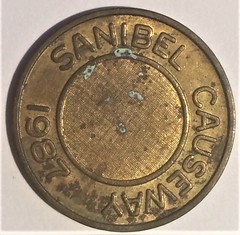 "It is coincidental that the collapse (September 2022) of the Sanibel Causeway during Hurricane Ian occurred just 35 years since the issue in 1987 of the Sanibel Causeway token.
"It is coincidental that the collapse (September 2022) of the Sanibel Causeway during Hurricane Ian occurred just 35 years since the issue in 1987 of the Sanibel Causeway token.
"Sanibel & its connecting island of Captiva (accessed by the Blind Pass Bridge), home & vacation spot of the famous, such as: NBA Legend Larry Bird, Eric Clapton, Tom Cruise, Johnny Depp, Tom Hanks, Stephen King, Steve Martin, Mike Pence, Joe Perry of Aerosmith etc) is serviced by a single conduit to the mainland of Ft. Myers (via Punta Rassa near Smuggler's Cove) called a causeway (a raised roadway over water).
"As early as 1912 a car ferry serviced Sanibel, but the idea of establishing a bridge was controversial in that the locals feared the onslaught of tourism. In due course there was too much pressure on the ferry service and after several hurricanes and the wildfire of 1955 an easier way to get on and off the island was needed. It took about a year and a half to complete the Causeway (and the original 3 bridges) which was opened in 1963. Interestingly, these tokens, which are highly oxidized with the front & back the same, were dated 1987, but never used."
Good luck with the continued cleanup and recovery for all those affected by the storm. -Editor
To read the complete article, see:
Numismatists deal with the aftermath of Hurricane Ian
(https://www.coinworld.com/news/us-coins/numismatists-deal-with-the-aftermath-of-hurricane-ian)
CDN PUBLISHING GLOBETROTS
Well beyond the Florida hurricane zone, John Feigenbaum of CDN Publishing shared a video and images of CDN visits to recent shows around the globe. Nice photos. I feel like a slug - I've only travelled back and forth to my office. -Editor
Between September 22 and October 2 the CDN Publishing team was present in Fredericksburg, Virginia, Maastricht, the Netherlands, Stockholm, Sweden, and Long Beach, California. While the Greysheet is extremely well known in the United States, our flagship product is not nearly as well recognized in Europe. In 2020, we added The Banknote Book, the world's most comprehensive catalog of world paper money, to our offerings, and our team has taken to the road to promote these and all our offerings.
It is truly one of the best parts of our work to come to these live shows and meet dealers and collectors in person.
The Greysheet booth at the VNA Show in Frederickburg, Virginia.
Scenes from Maastricht and the bourse floor.
The Greysheet makes landfall in Stockholm, home to beautiful people, beautiful coins, and home to one of the richest areas of numismatic literature on the planet.
To read the complete article, see:
Two Weekends, Four Shows Across Two Continents [Video]
(https://www.greysheet.com/news/story/two-weekends-four-shows-across-two-continents-video)
VOCABULARY TERM: MARRIAGE MEDAL
Here's another entry from Dick Johnson's Encyclopedia of Coin and Medal Terminology. I added an image of the Samuel and Mary Bell medal. -Editor
Marriage Medal. A medallic item issued on the occasion of a marriage or on the anniversary of a marriage. The most obvious design, of course, is portraits of the wedded couple. In addition to medals issued at the time of a wedding ceremony, anniversary medals have been issued on significant anniversaries. Most medallic companies offered stock medals for engagement, marriage and wedding anniversary themes. These dies could, of course, be engraved, or struck pieces inscribed to customize for any couple or occasion.
Royal families have issued marriage medals for centuries. The custom continues to he present, as exemplified by marriage medals issued for royal families in England, Bulgaria, Denmark, Sweden and The Netherlands.
Wedding anniversary medals are issued for the more important anniversaries, particularly 25th, 50th, 60th, and infrequently for the 40th or 75th. These are often instigated and sponsored by the children more so than anyone else. A wide range of marriage and wedding anniversary medals exist, from elaborately executed to stock designs. Royalty, wealthy and famous families have issued these medals, but so also have common folk. Generally only a sufficient quantity of marriage medals are struck to dispense to the relatives and friends who attend the wedding or anniversary celebration.
The United States Mint struck two marriage medals. One in 1821 for Robert and Louisa Gilmore (50th anniversary, Julian PE-13) and one in 1856 for Samuel and Mary Bell (25th anniversary, PE-5). Julian reports Mint Director James Ross Snowden traded restrikes of the Gilmore medal for coins he wanted in the mint collection. Otherwise marriage medals are seldom reissued or restruck.
In Germany oval wedding anniversary medals with loop for suspension, heavily enameled and jewel encrusted were called gnadenmadillen. These were popular among princes in the Holy Roman Empire.
References:
O37 {1977} Julian.
NE40 {1984} Junge p 118.
To read the complete entry on the Newman Numismatic Portal, see:
Marriage Medal
(https://nnp.wustl.edu/library/dictionarydetail/516266)
SYLVESTER SAGE CROSBY (1831-1914)
American Numismatic Biographies author Pete Smith submitted this article on numismatic researcher and author Sylvester Sage Crosby. Thanks! The pictured newspaper article is from The Boston Globe of June 13, 1907, page 11. -Editor
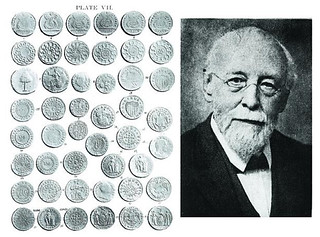 In a recent article, I mentioned a photograph that Joseph Saxton took from a window in the U. S.
Mint in 1839. It would be years before photos would be used to illustrate coin books. For the
next 35 years, publishers used woodcuts, steel plate engravings and metal-ruled plates. It would
not be until 1875 that the first photo illustrated book appeared.
In a recent article, I mentioned a photograph that Joseph Saxton took from a window in the U. S.
Mint in 1839. It would be years before photos would be used to illustrate coin books. For the
next 35 years, publishers used woodcuts, steel plate engravings and metal-ruled plates. It would
not be until 1875 that the first photo illustrated book appeared.
The name of Sylvester Sage Crosby should be familiar to anyone with enough interest in numismatics to read The E-Sylum. Although parts of his story may be familiar, perhaps other parts are not.
Harvard graduate, the Reverend Jaazaniah Crosby (1789-1864) and wife Hulda Robinson Sage (1795-1835) welcomed their sixth child in 1824 and named him Sylvester Sage Crosby after his maternal grandfather, Yale graduate, the Reverend Sylvester Sage (1765-1841). The young child died on April 7, 1825. As often happened back then, they gave the same name to their ninth child, born in Charlestown, New Hampshire, on September 2, 1831.
The second Sylvester married twice. He married his first wife, Mary Elizabeth Capelle, on September 1, 1855, and she died on October 26, 1874. Less than a year later he married Mehitable Ackers on September 15, 1875. Neither marriage produced children.
He began working as a watchmaker at age 17 in Charlestown, but he moved to Cambridge, Massachusetts, and set up business in Boston. He was a partner in the watch and jewelry business with Horatio Towne at 421 Washington Street in Boston. In addition to numismatics, he enjoyed archeology, astronomy and fungiculture.
Crosby contributed an article on the cents of 1793 to the American Journal of Numismatics for their issue of April 1869. Later he compiled AJN articles into The United States Coinage of 1793 Cents and Half Cents published in 1897. This included description of the patterns of 1792.
Crosby was one of the founding members of the New England Numismatic and Archeological Society on April 6, 1866. He was the club's first curator. In 1869, the vice president, Charles Chapman, suggested the club form a committee to write a reference on the coins of Colonial America. Crosby was chairman of the committee with other members Charles Chapman, Dudley R. Child, Chas. S. Fellows, James E. Root and T. Edward Bond.
The book had a grand title, The Early Coins of America; and the Laws Governing Their Issue. Comprising also Descriptions of the Washington Pieces, the Anglo-American Tokens, Many Pieces of Unknown Origin, of the Seventeenth and Eighteenth Centuries, and the First Patterns of the United States Mint.
The ambitious plan was for the book to be published in ten parts and sold by subscription at $1 per part. Each part would be 32 pages, include one plate of photographic illustration and sent out with a paper wrapper. Print run for the book would be 350 copies.
That plan failed to materialize as the book progressed. The committee of six provided little support and left the work to Crosby alone. He scoured historical archives for the legislative records establishing coinage and borrowed coins for photography. By the final printing, the list of subscribers had grown to just 160 with 22 organizational subscribers and 138 individuals. That generated revenue of just $1600 and not the anticipated $3500.
The first five parts were printed by Charles Chaplin who dropped out with remaining parts printed by T. R. Marvin & Sons, printer for the American Journal of Numismatics. Financial support came from the New England Numismatic and Archaeological Society as publisher in 1873 but by completion in 1875, Crosby was listed as publisher.
The book was longer than expected and final parts 11 & 12 were published together to finish the book at 384 pages. Subscriber were asked for an additional $2 to get these final parts. The original print run was 350 copies and many buyers had their sets bound in a variety of bindings. Unbound sets are seen occasionally and the paper wrappers are scarce. The book was republished in 1945, 1965, 1970, 1974 and 1983.
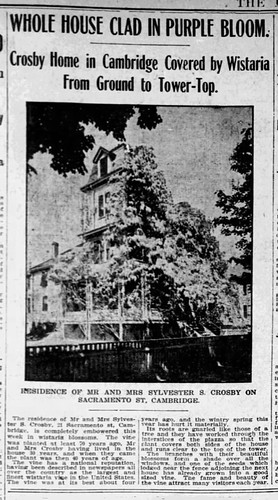 Each of the parts included one Heliotype photo plate. The process had been developed in
England by Ernest Edwards in 1869. Waxed glass plates were covered in bichromated gelatin
exposed by sunlight through a negative. These were washed and the image transferred to a
pewter printing plate.
Each of the parts included one Heliotype photo plate. The process had been developed in
England by Ernest Edwards in 1869. Waxed glass plates were covered in bichromated gelatin
exposed by sunlight through a negative. These were washed and the image transferred to a
pewter printing plate.
The photos have a very uniform appearance and were not made from actual coins. Plaster casts were made from the coins and the photos taken of those plaster casts. An advantage was that coins could be gathered from various sources and did not need to be in the same place at the same time to allow for photography. The obverse and reverse of a coin could be shown on the same plate.
Reviews of the book were generally positive and the book remains a classic work to this day. A review was published by Edward Maris in the October issue of the American Journal of Numismatics. It was complimentary of some aspects of the book but critical for noted omissions. It was also critical that some additional collections were not included among the sources. Maris made up a Woodburytype plate of 48 state coppers missing from the book and offered it to the original subscribers for 50 cents. Some had it bound with their copies. This additional plate was included in the 1983 Quarterman reprint of Early Coins of America.
Crosby died at home in Cambridge on August 18, 1914. He is buried at the Monroe Cemetery in Lexington, Massachusetts. Crosby was given an honorary membership in the American Numismatic Society and the American Numismatic Association. The ANS had names of numismatic scholars cut in stone for the frieze of the building. Crosby was the only American honored in this way. In 1970 he was inducted into the ANA Numismatic Hall of Fame.
To read the earlier E-Sylum articles, see:
SYLVESTER SAGE CROSBY'S PERSEVERANCE PREVAILS
(https://www.coinbooks.org/esylum_v16n15a16.html)
ARTHUR HENRY FRAZIER (1899-2000) : Joseph Saxton (1799-1873)
(https://www.coinbooks.org/v25/esylum_v25n39a14.html)
FALL 2022 PAN CIVIL WAR SHOWCASE
Rick Lank and Becky Rush are hosting another Civil War Money & Memorabilia Showcase at the fall 2022 show of the Pennsylvania Association of Numismatists (PAN). Here's the announcement. -Editor
October 20, 21 & 22 at the Monroeville PA Convention Center
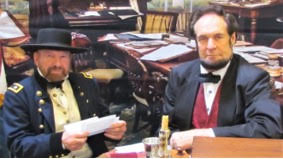 The Showcase this year will feature a return of General Sherman and Honest Abe to discuss matters such as
The Showcase this year will feature a return of General Sherman and Honest Abe to discuss matters such as Uncle Billy
Sherman's early days in the Gold Days of California, when he was the Manager of the San Francisco branch of Lucas, Turner & Co. Sherman also recalled later in the War marching through Milledgeville, Georgia – where his troops burned 1,000s in State of Georgia notes. Lincoln and Sherman are slated to join Lank and Rush on Saturday for discussion about What was in your pockets, General Sherman & President Lincoln,
taking a close look at coins, paper money, tokens, and talismans of the 1860s.
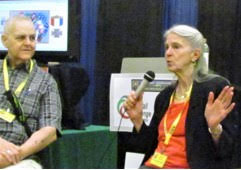 On Friday morning, collector Terry Carver and Showcase co-founder Becky Rush will discuss both GAR (Great Army of the Republic) and WRC (Women's Relief Corps) medals and memorabilia.
On Friday morning, collector Terry Carver and Showcase co-founder Becky Rush will discuss both GAR (Great Army of the Republic) and WRC (Women's Relief Corps) medals and memorabilia.
The duo will discuss a wide range of medals, medallions & collectibles created by Northern veteran groups after the War. Terry and Richard Crosby will display a wide assortment of rare items at the Showcase.
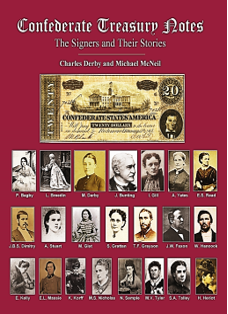 The Civil War Showcase team leads a discussion about the
folks who actually signed the Confederate Paper Money,
based on the upcoming book by Charles Derby & Michael
McNeil. These portraits and biographical sketches reveal a human face
and a life-story behind the men and women who signed their own names
(on behalf of the CSA Treasury) on thousands of Confederate notes.
This book – due out in January '23 -- has identified over 200 individuals
whose own names are affixed to the CSA Paper Money; most of the
signing took place in Richmond VA and Columbia SC (the location of
Evans & Cogswell, the largest printing firm that churned out paper
money. The Evans & Cogswell plant was torched when Sherman came
through in early '65. This story dovetails nicely into the GAR
presentation, as each GAR post in the US was gifted
The Civil War Showcase team leads a discussion about the
folks who actually signed the Confederate Paper Money,
based on the upcoming book by Charles Derby & Michael
McNeil. These portraits and biographical sketches reveal a human face
and a life-story behind the men and women who signed their own names
(on behalf of the CSA Treasury) on thousands of Confederate notes.
This book – due out in January '23 -- has identified over 200 individuals
whose own names are affixed to the CSA Paper Money; most of the
signing took place in Richmond VA and Columbia SC (the location of
Evans & Cogswell, the largest printing firm that churned out paper
money. The Evans & Cogswell plant was torched when Sherman came
through in early '65. This story dovetails nicely into the GAR
presentation, as each GAR post in the US was gifted souvenir
Confederate currency in 1912 by the US Treasury (it was confiscated at
the War's end nearly 50 years earlier). The Talk will be on Thursday.
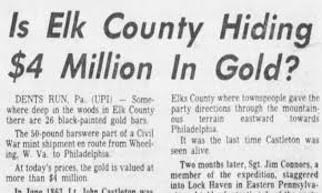 It has been the subject of speculation &
cover-ups, tall tales and treachery… as
the story goes, millions of dollars in gold
bars, hidden in false bottom wagons, were
making the trek from Wheeling, WV to
the US Mint in Philly… with only a small
guard of Union soldiers. It was the summer of
1863… and Gen. Lee's Army was invading
Pennsylvania… as the story is told, the wagon-train
was sent much further north than originally planned –
otherwise they'd be heading straight into Gettysburg on what is now Route 30. They made to Dent's Run,
northeast of Pittsburgh, and disappeared. Human remains were found in the area 10 years later. Treasure
hunting team
It has been the subject of speculation &
cover-ups, tall tales and treachery… as
the story goes, millions of dollars in gold
bars, hidden in false bottom wagons, were
making the trek from Wheeling, WV to
the US Mint in Philly… with only a small
guard of Union soldiers. It was the summer of
1863… and Gen. Lee's Army was invading
Pennsylvania… as the story is told, the wagon-train
was sent much further north than originally planned –
otherwise they'd be heading straight into Gettysburg on what is now Route 30. They made to Dent's Run,
northeast of Pittsburgh, and disappeared. Human remains were found in the area 10 years later. Treasure
hunting team Finders Keepers
thought they found the spot a few years back. The FBI caught wind of the
find… and moved in… and legal battles have been making the news right up to this year… we'll dig deeper
and share some local lore about the Treasure's fate. The Talk will be on Thursday afternoon.
The Civil War Showcase will be in the same area as the KidZone & PAN Lecture Area
For more information on the PAN show, see:
https://pancoins.org/
NUMISMAGRAM MEDAL SELECTIONS: OCTOBER 2022
Jeremy Bostwick of Numismagram forwarded these three medals that were a part of his recent upload of new material. Some of the other highlights include a medal relating to the execution of Louis XVI, a plaque pertaining to the International Health Exhibition held in Dresden in 1911, and a silver medal commemorating the Apollo 11 lunar mission. For all of these new additions, please visit https://www.numismagram.com/inventory. -Editor
102167 | GERMANY. New Century silver Medal. Issued 1900 (38mm, 28.48 g, 12h). By C. Starck & O. Oertel in Berlin. Facing sphinx / ZUR / JAHR- / HUN- / DERTS – WENDE, Hora, in sheer, full-length drapery, standing slightly left, extinguishing one torch and holding another upright. Edge: 990. Strothotte 1900-3; Marienburg 7159; Heidemann 855; GPH 5082. Choice Mint State. Pleasingly toned. $245.
Offering great Neoclassical artistry, this piece was created for the dawn of the 20th century, seemingly featuring a mythological allegory for the passage of time, Hora. Here, she is depicted in a very sheer drapery, her apparent nakedness revealing the exploits of the previous century, yet her clothing at least obfuscating the events of the new century.
To read the complete item description, see:
102167 | GERMANY. New Century silver Medal.
(https://www.numismagram.com/product-page/102167)
102096 | GERMANY & GREAT BRITAIN. Sir Edward Grey cast iron Medal. Issued circa 1915/6. On Grey's "obligation of honour" to France and Belgium (56mm, 52.84 g, 12h). By E. Otto for Gladenbeck & Son in Berlin. DATVM EST EI OS LOQVENS MAGNA ET BLASPHEMIAS (it was given a mouth from which to speak haughty and blasphemous words...), three-headed winged mythical beast rearing left; in two lines in exergue, QVIS SIMILIS / BESTIÆ (...who is this that acts so beastly? [—adapted from Revelation 13:5]) / SIR EDWARD GREY above a quill. Edge: DS 66 6. Klose –; Art of Devastation – (though cf. 7513.15202.1.a in the Society's collection); Steguweit 143. Mint State. Graphite gray surfaces, with a light matte nature. A very rare and interesting type from a lesser-seen World War I satirical series. $295.
Sir Edward Grey, 1st Viscount Grey of Fallodon, served as British Foreign Secretary from 1905-1916, convincing the cabinet that a declaration of war against Germany was necessary as an "obligation of honour" to an alliance with France and a previous pledge that Belgium would not be invaded. Here, Otto presents Grey's Britain, along with France and Belgium, as a three-headed monster against his native Germany. He also draws inspiration from the Book of Revelation with the obverse legend, as well as a fairly close mimicking of an extremely rare 1687 Dutch medal on Pierre Jurieu, a 17th century leader in the French Protestant movement: https://www.britishmuseum.org/collection/object/C_G3-FD-99
To read the complete item description, see:
102096 | GERMANY & GREAT BRITAIN. Sir Edward Grey cast iron Medal.
(https://www.numismagram.com/product-page/102096)
102149 | GREAT BRITAIN. Gresham Angling Society silver Award Medal. Issued 1893 for specimen fish (39mm, 21.54 g, 12h). Engraved and awarded to E. Hesse of Chisenhale Road, Old Ford. Grasshopper left above ribbon reading GRESHAM ANGLING SOCIETY; around, border with fish, basket, hooks, nets, and tackle / PRIZE FOR SPECIMEN FISH, engraved in three lines in center, "E. HESSE / Dace / 1893"; garlanded wreath below. Edge: Plain. Choice Mint State. Deeply toned, with an intense ring of iridescence and shimmering brilliance in the fields. Incredibly attractive and alluring. $395.
Hesse appears to have won this medal for the exhibition of a dace, a type of freshwater fish in the minnow family. An advertisement in the 1893 publication "Red Palmer: A Practical Treatise on Fly-Fishing" by James Tayler conveys Hesse's accolades, in that:
E. Hesse,
of the Gresham Angling Society,
Animal, Bird & Fish Preserver,
59, Chisenhale Road, Old Ford,
Near the "Earl of Aberdeen," Reiman Road.
Specialist in Fish Mounting.
Inventor of the New "Natural" Eye, (for Fish)
First Class Exhibition Medal.
Price List on Application.
Based upon this ad, it would appear that Hesse was an accomplished taxidermist who perfected a fake eye to be used in the mounting of fish for display, likely using this award medal in his adverts.
To read the complete item description, see:
102149 | GREAT BRITAIN. Gresham Angling Society silver Award Medal.
(https://www.numismagram.com/product-page/102149)
COLLECTION OF AN ENGLISH DOCTOR, PART THREE
Sovereign Rarities in London is offering the third and final part of a collection of early Anglo-Saxon coins at fixed prices. Here's the press release. -Editor
Part Three – Concluding Part
A Celebration of the English Penny
Sovereign Rarities are very proud to present the third and final part of The Collection of an English
Doctor
to offer for sale through our website www.sovr.co.uk at fixed prices. Formed by a very
discerning collector of many years standing, this English collection formed diligently over the last few
years, aims to illustrate the history of the English silver Penny, with the criteria being to collect as
many mints and moneyers as possible in the time that was allowed.
Continuing on chronologically from the recent parts one and two, this final part contains Plantagenet
through the houses of Lancaster and York, the Tudors and the Stuarts to end with the last
hammered issues of the Commonwealth - the total consisting of 145 coins.
It can be difficult to pick highlight pieces especially when there are so many in such a large grouping,
but the rarest and most unusual pieces are clearly the most interesting, a top tenas follows in reign
and mint order:
GM24325 Carlisle
Richard I (1189-99),
silver short cross Penny, class 4a (c.1194-c.1200), in the name of his Father,
Carlisle Mint, moneyer Alain, facing crowned head with linear collar, hand holding sceptre at left,
Latin legend and beaded borders surrounding both sides, commences upper left, hENRICVS R E X,
rev. short voided cross pommee, small cross pommee in each angle, +ALaIN. ON. CARD, note lower
case A in moneyer name, weight 1.46g (BNJ XLIX, Allen dies 425/425 and pl. vii, 40, this coin; cf.Mass
954; N.968/1; S.1348A). Toned, well struck and centred, very fine and very rare. £1,150
Provenance:
Ex F. Elmore-Jones, Part II, Glendining, 10th April 1984, lot 1502.
Ex John Mattinson Collection of Carlisle Mint, part I, Dix Noonan and Webb, Auction 164, 9th October 2019, lot 2250.
Ex Collection of an English Doctor part III, Sovereign Rarities fixed price list online September 2022.
To read the complete item description, see:
Richard the Lionheart, short cross Penny, class 4a, Carlisle Mint, moneyer Alain
(https://www.sovr.co.uk/collections/usf_sort-metafield-3aproducts-year/products/richard-the-lionheart-short-cross-penny-class-4a-carlisle-mint-moneyer-alain-gm24325)
GM24327 Shrewsbury
Richard I (1189-99),
silver short cross Penny, class IVb (c.1200-1204), in the name of his Father,
Shrewsbury Mint, moneyer Ive, facing crowned bust with sceptre outside inner linear circle, legend
commences upper left, hENRICVS R EX, rev. short voided cross pommee, cross pommee in each
angle, beaded circles and legend surrounding, +IVE. ON. SALOP, weight 1.25g (Mass 1140; N.968/2; S.1348C). Toned with some flat spotting in striking, otherwise with a good portrait and clear mint
name, good very fine for issue. £850
Provenance:
Ex F. Elmore-Jones, Glendining, 10 th April 1984, lot 1506.
Ex North York Moors Collection, Dix Noonan and Webb, Auction 159, 2rd July 2019, lot 486.
Ex Chislehurst Collection, Dix Noonan and Webb, Auction 179, 9th September 2020, lot 18.
Ex Collection of an English Doctor part III, Sovereign Rarities fixed price list online September 2022.
To read the complete item description, see:
Richard I Penny, type IVb, Shrewsbury Mint, Moneyer Ive, local silver
(https://www.sovr.co.uk/collections/usf_sort-metafield-3aproducts-year/products/richard-i-penny-type-ivb-shrewsbury-mint-moneyer-ive-local-silver-gm24327)
GM24341 Rhuddlan
John (1199-1216),
silver Penny, short cross type, in the name of his Father, Rhuddlan Mint Wales
(1190-1215), group I class ii, moneyer Tomas, facing crowned head with linear collar, hand holding
sceptre at left, legend with inner linear and outer beaded border surrounding, commences upper
left, hNERICVS. R EX, note error in spelling, the N retrograde, rev. short voided cross pommée, small
cross pommée in each angle, initial mark trefoil of pellets, legend surrounding with inner and outer
beaded border, +TOMAS. ON. RVLA, the N retrograde, weight 1.19g (Mass 2175; N.972/2; S.p.167).
Once lightly cleaned, now toned and well struck for this distinctive localised issue, good very fine and
rare. £1,950
Provenance:
Ex Spink Numismatic Circular, April 2003, HS1210.
Ex Neil and Gina Smith Collection, The New York Sale XLIX, 15th January 2020, lot 1238, hammer $1,500
Ex Collection of an English Doctor part III, Sovereign Rarities fixed price list online September 2022.
To read the complete item description, see:
John Penny, Rhuddlan Mint Wales, moneyer Tomas
(https://www.sovr.co.uk/collections/usf_sort-metafield-3aproducts-year/products/john-penny-rhuddlan-mint-wales-moneyer-tomas-gm24341)
GM24397 Reading
Edward III (1327-77),
silver Penny, third Florin type coinage (1344-51), Reading Mint, issued by the
Abbot of Reading, facing crowned bust with shoulders, beaded circles and legend surrounding,
Roman N in legend without stops, +EDWAR R ANGL: DNS hYB, rev. long cross pattee, tri-pellets in
each inner angle except second which has a scallop shell, beaded circles and legend around, VIL LA R
ADI NGY weight 0.99g (SCBI 39:1088 North; N.1129; S.1555). Toned, weakly struck a little off-centre
with some ghosting, otherwise about very fine and very rare and on par, if not better than the two
examples listed in the J J North Collection sylloge. £1,000
To read the complete item description, see:
Edward III Penny, Florin type coinage, Reading Mint, scallop in one quarter
(https://www.sovr.co.uk/collections/usf_sort-metafield-3aproducts-year/products/edward-iii-penny-florin-type-coinage-reading-mint-scallop-in-one-quarter-gm24397)
GM24398 Reading
Edward III (1327-77),
silver Halfpenny, third Florin type coinage (1344-51), Reading Mint, issued by
the Abbot of Reading, facing crowned bust with shoulders, beaded circles and legend surrounding
without stops, +EDWARDVS REX, rev. long cross pattee, tri-pellets in each inner angle except fourth
which has a scallop shell, beaded circles and legend around, VIL LA R ADI NGY weight 0.60g (SCBI
39:1108 North; Withers type 7; N.1133; S.1560). Lightly toned, double struck on obverse and a little
off-centre both sides, about very rare, with the important details clear and on par, if not better than
the two examples listed in the J J North Collection sylloge. £875
To read the complete item description, see:
Edward III Halfpenny, Reading Mint, scallop shell in one quarter
(https://www.sovr.co.uk/collections/usf_sort-metafield-3aproducts-year/products/edward-iii-halfpenny-reading-mint-scallop-shell-in-one-quarter-gm24398)
GM25192
Edward VI (1547-53),
silver Penny, fine silver issue (1551-53), Sovereign type, London Mint, facing
seated figure of King on throne with orb and sceptre, two pillars of throne visible, Latin legend and
beaded border surrounding with lozenge stops, initial mark tun (1551-53) both sides, E. D. G. ROSA.
SInE. SPI., rev. long cross fourchee over quartered shield of arms, Latin legend and beaded borders
surrounding, CIVI TAS LON DON, weight 0.50g (N.1942; S.2487). Toned, a little double struck on
obverse, with clear details and mint marks, a bold to good very fine and extremely rare. £7,500
Provenance:
Ex Baldwin of St James, Auction 16, 17th April 2018, lot 286.
Ex Dix Noonan Webb, Auction 166, 23rd January 2020, lot 50.
Ex Collection of an English Doctor part III, Sovereign Rarities fixed price list online September 2022.
To read the complete item description, see:
Edward VI Penny, Sovereign type, London Mint, mm tun
(https://www.sovr.co.uk/collections/usf_sort-metafield-3aproducts-year/products/edward-vi-penny-sovereign-type-london-mint-mm-tun-gm25192)
GM25193
Mary Tudor (1553-54),
silver portrait Penny, Tower Mint London, first type, crowned bust left with
pearl earring and necklace, linear and beaded circles with abbreviated Latin legend with Roman style
lettering surrounding, no initial mark, pellet stops, M'. D'. G'. ROSA. SINE. SPINA., rev. long cross
fourchee over quartered shield, legend VERI TAS& TEMP FILIA, mint mark pomegranate after TAS,
weight 0.58g (N.1962; S.2494). A little uneven in shape with a light crease, some light porosity and
scratch behind bust, one light surface crack to reverse, otherwise fine, reverse very fine and
extremely rare. £2,500
Provenance:
Ex Dr John Hulett Collection, part VI, Dix Noonan and Webb Auction 148, 18th September 2018, lot 341.
Ex Collection of an English Doctor part III, Sovereign Rarities fixed price list online September 2022.
To read the complete item description, see:
Mary Tudor, portrait silver Penny, Tower Mint, extremely rare
(https://www.sovr.co.uk/collections/usf_sort-metafield-3aproducts-year/products/mary-tudor-portrait-silver-penny-tower-mint-extremely-rare-gm25193-1)
GM25216 Aberystwyth
Charles I (1625-49),
silver Halfpenny, Aberystwyth Mint (1638-42), rose with outer beaded border,
rev. Welsh plumes with outer beaded border, weight 0.24g (Withers 2; Brooker 704; N.2274;
S.2851). Toned rim chips, good very fine and extremely rare. £4,250
Provenance:
Ex P. Frank Purvey, post Seaby days.
Ex Dr John Hulett, part XIV, Dix Noonan Webb, Auction 165, 4th December 2019, lot 186.
Ex Collection of an English Doctor part III, Sovereign Rarities fixed price list online September 2022.
To read the complete item description, see:
Charles I, Halfpenny, Aberystwyth Mint, Wales
(https://www.sovr.co.uk/collections/usf_sort-metafield-3aproducts-year/products/charles-i-halfpenny-aberystwyth-mint-wales-gm25216)
GM25217 Oxford
Charles I (1625-49),
silver Penny, Oxford Mint (1642-46), crowned bust left, value I behind head,
legend and beaded borders surrounding, mint mark lis both sides, +CAROI. D: G: M: B: F: ET H: REX,
rev. Oxford plumes with bands, legend and beaded borders surrounding, +IVSTITIA. THRO. FIRMAT,
weight 0.44g (Brooker 967; N.2479; S.3001). Toned very fine to good very fine for issue and
extremely rare, perhaps the finest of those known. £2,500
Provenance:
Ex W. Talbot Ready, Sotheby, 15th November 1920, lot 692 part, sold for £44/10/-
Ex L. E. Bruun, part I, Sotheby, 18-22nd May 1925, lot 786, plate XXI sold for £21/10/- (A Una 1839 £5 at that time sold for £10/10/- for comparison).
Ex Classical Numismatic Group, Webshop 2020.
Ex Collection of an English Doctor part III, Sovereign Rarities fixed price list online September 2022.
To read the complete item description, see:
Charles I, Penny, Oxford Mint, mm lis
(https://www.sovr.co.uk/collections/usf_sort-metafield-3aproducts-year/products/charles-i-penny-oxford-mint-mm-lis-gm25217)
GM25219 Bristol
Charles I (1625-49),
silver Penny, Bristol Mint, crowned bust left, value I behind, legend and beaded
borders surrounding, initial mark pellet, .CAROLVS. D: G: M: B: F: E: H: REX, rev. large plumes with
bands, legend and beaded borders surrounding, .IVSTITIA. THRONVM. FIRMAT, weight 0.42g
(Brooker -; N.2511; S.3027). Toned and a little off-centre on reverse, a bold very fine, reverse a little
weaker, extremely rare with an old provenance. £5,250
Provenance:
Ex Samuel Birchall (1761-1814), collection not sold till Dix Noonan and Webb, Auction 191, 4th May 2021, lot 126.
Ex Collection of an English Doctor part III, Sovereign Rarities fixed price list online September 2022.
To read the complete item description, see:
late Declaration issue
(https://www.sovr.co.uk/collections/usf_sort-metafield-3aproducts-year/products/charles-i-penny-bristol-mint-or-late-declaration-issue-gm25219)
For more information, see:
https://www.sovr.co.uk/
To read the earlier E-Sylum articles, see:
COLLECTION OF AN ENGLISH DOCTOR, PART ONE
(https://www.coinbooks.org/v25/esylum_v25n10a22.html)
COLLECTION OF AN ENGLISH DOCTOR, PART TWO
(https://www.coinbooks.org/v25/esylum_v25n22a19.html)
https://www.coinbooks.org/v25/esylum_v25n23a21.html
(https://www.coinbooks.org/v25/esylum_v25n23a21.html)
THE BOOK BAZARRE
DAVISSON'S E-AUCTION 45
Allan Davisson of Davissons Ltd published this announcement of the firm's upcoming E-Auction 45. -Editor
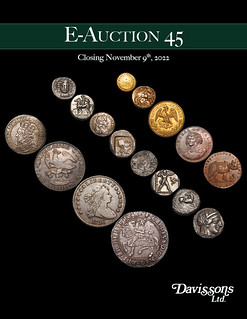 E-Auction 45, closing Wednesday, November 9th 2022, is online now! Print copies are being sent this week, if you are not on our mailing list and would like a copy please let us know.
E-Auction 45, closing Wednesday, November 9th 2022, is online now! Print copies are being sent this week, if you are not on our mailing list and would like a copy please let us know.
This catalog is very much a story of consignors. Seven different collectors are represented in this sale, and their efforts and taste are an important part of what this catalog represents. We write the descriptions, the grading and the estimates, but the pieces themselves reflect what was important to the past owners.
Some of our consignors have small sections in this catalog reflecting adjustments to their current interests. Other consignments represent someone letting go. One such collection is a continuation of our offering of a large collection of crowns and crown size pieces—the US 1798 and 1846 dollars are his. Rather than offer his entire collection at once, we have been spreading it out over a few sales. We are also introducing coins from another consignor whom we have known personally for many years as a Minnesota collector who would often stop by our table when we used to attend local shows. He formed a particularly well-thought-out and appealing collection of Greek and Roman coins and 20 of his pieces are an important part of the ancient section of this catalog.
Another consignment comes from one of the leading scholars in the numismatic community, Robert W Hoge, who sent a small widely varied tranche of pieces. In addition to possessing a distinguished corpus of publications and academic and museum posts, he was Curator of the American Numismatic Association (ANA) Money Museum in Colorado Springs in 1981, followed by his post serving as Curator of North American Coins and Currency at the American Numismatic Society in New York. (He is now Curator Emeritus.) He has pursued some specialized areas of interest as a collector and it is a select group of coins from that collection that we are offering here. Each of his lots is designated as The RWH Collection. He provided detailed descriptions for each of his coins which we will provide to each purchaser along with the lot. (For reasons of space we have shortened the descriptions and have made our own grading notes.)
The most significant consignment in this catalog of 325 lots is a group of 133 coins from the estate of Patrick Zabel, an advanced collector who did business with many U.S. and British dealers in the latter part of the 20th century. He was a collector with wide-ranging interests and he put together significant representations of important parts of numismatic history. In this catalog we have sampled pieces from different aspects of his collection—ancient Greece and Rome, British Celtic and Anglo-Saxon, Spanish America, European. There is much more to come.
The collection of Mexican coins he formed covers the history of Mexico as it grew from a colony of Spain to the modern Mexican state. He well represented America's first coinage as it occurred under Charles (Carlos) and Johanna. In addition to several silver pieces from their reign he also had a rare 4 maravedis piece—the first copper coin of Mexico—a particularly rare variety with the name Carlos
beginning with a CH.
Most of the rest of Mexico's changing governments are well represented—the Spanish Hapsburgs, the Bourbon rulers, the brief Empire of Iturbide, the First Republic, then the brief Maximilian Empire followed by the Second Republic and the United States of Mexico—the history of a nation in 65 lots. You will see Revolutionary Mexico in a later sale.
A few pieces from his Anglo-Saxon coinage are also here. This is one of the better Anglo-Saxon collections to appear on the market in recent years. That collection will be the feature for our major February 2023 sale, our special annual sale where we offer the best of what we have been able to find over the year. You can see a preview of that particular coming attraction
on the back cover of the print catalog or by opening the virtual catalog on the website.
The offering of British trade tokens includes some marvelous pieces from Baldwin's basement I came upon while researching my update of Dalton & Hamer in the 1980s, and others from the iconic Jim Noble Sale I attended in Melbourne in 1998.
When I began these notes I was contemplating the pleasures of ownership, inevitably a transient experience. And it led me to admiring the efforts serious collectors make to create some order for an area. For most, it is a private form of scholarship, of travel through time, of developing a deepening understanding of something. And finally, it is satisfying to realize that what we and others have appreciated and enjoyed for a time will now become a source of appreciation and enjoyment for many others as well.
For more information, see:
https://davcoin.com/
NUMISMATIC NUGGETS: OCTOBER 9, 2022
Here's a selection of interesting or unusual items I came across in the marketplace this week. Tell us what you think of some of these. -Editor
MEXICO. 8 Reales, 1879-Pi BE. San Luis Potosi Mint. PCGS Genuine--Chopmark, VF Details.
KM-377.12; DP-Pi66. With red tape chop character "xixi" (double happiness) on the obverse.
Chopmark News editor Colin Gullberg alerted readers that "Member Brett Moyer is selling a fine example of a wedding chop Mexican 8R in a Stack's sale in a few days." Interesting item. -Editor
To read the complete lot description, see:
MEXICO. 8 Reales, 1879-Pi BE. San Luis Potosi Mint. PCGS Genuine--Chopmark, VF Details.
(https://auctions.stacksbowers.com/lots/view/3-YVNF5/mexico-8-reales-1879-pi-be-san-luis-potosi-mint-pcgs-genuine-chopmark-vf-details)
Pleasing 1982 Edouard Manet medal in bronze and issued by the Monnaie De Paris. Front-facing bust of Manet on obverse; image of a child playing flute on reverse. Monnaie De Paris privy mark and date on edge.
From the eBay offerings of the American Numismatic Society. -Editor
To read the complete lot description, see:
France - 1982 - Edouard Manet Commemorative Medal - Monnaie De Paris
(https://www.ebay.com/itm/134258003663)
Vintage Sterling Silver Baseball Medal UNUSED
Marked Sterling but no maker mark. Never engraved.
1.5" with jump ring, 1" wide.
Very Good Condition.
What better for the tail end of baseball season than a silver baseball medal? Has anyone ever seen an engraved one of these? -Editor
To read the complete lot description, see:
Lot 313: Vintage Sterling Silver Baseball Medal UNUSED
(https://www.invaluable.com/auction-lot/Vintage-Sterling-Silver-Baseball-Medal-UNUSED-313-c-C414AD1828)
BYZANTINE COIN FIND IN ISRAEL
Dick Hansom forwarded this BBC article on a recent find of Byzantine coins in Israel. Thanks. -Editor
Archaeologists in Israel say 44 pure gold coins dating to the 7th Century have been found hidden in a wall at a nature reserve.
Weighing about 170g, the hoard found at the Hermon Stream (Banias) site was hidden during the Muslim conquest of the area in 635, experts estimated.
They said the coins shed light on the end of the Byzantine rule in the area.
"We can imagine the owner concealing his fortune in the threat of war, hoping to return one day to retrieve his property," said Yoav Lerer, director of the excavation.
"In retrospect, we know that he was less fortunate."
Apart from the gold coins, the excavation - in a residential quarter of the ancient city - also uncovered the remains of buildings, water channels and pipes, bronze coins and much more, Israeli authorities said.
Dr Gabriela Bijovsky, a numismatic (currency) expert at the Israel Antiquities Authority, said some of the coins were of Emperor Phocas (602-610), but most were of his successor Heraclius.
Thanks also to Kavan Ratnatunga, Aaron Oppenheim, and Howard Berlin, who forwarded articles from other publications (linked below). -Editor
Kavan adds:
"I have got a coin of this era posted on my website, as one was found in Anuradhapura."
To visit the page on Kavan's website, see:
Constans II 641-668 CE
Byzantine Gold Solidus
(http://coins.lakdiva.org/byzantine/641_668_constanii_sol_au.html)
To read the complete articles, see:
Gold coins hidden in 7th Century found in wall
(https://www.bbc.com/news/world-middle-east-63122180)
Israel: Cache of 44 gold coins discovered hidden in wall
(https://www.i24news.tv/en/news/israel/archeology/1664878425-israel-cache-of-44-cold-coins-discovered-hidden-in-wall)
Cache of 44 Byzantine-era solid gold coins uncovered in Israeli nature reserve
(https://www.jpost.com/archaeology/article-718813)
THE 1930 AUSTRALIAN PENNY
Don Cleveland passed along this article about the recent sale of a circulated 1930 Australian penny, a rare date. Thanks. None of the article's images show the coin's date, so we'll have to take their word for it. -Editor
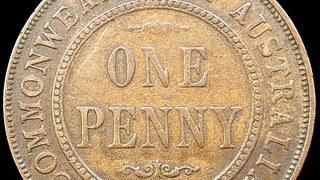 A rare 1930 Australian penny that was never meant to be minted has sold for just under $60,000 at auction.
A rare 1930 Australian penny that was never meant to be minted has sold for just under $60,000 at auction.
The 1930 penny was sold at a national online auction last night for $59, 415 to a Western Australian bidder, who intends to pass the coin on to his grand children.
Auctioneers believe it is a record sale price for a circulated Australian penny in 'good/fair' condition.
Head of fine art and luxury at Lloyds Auctioneers and Valuers Amanda Benson told ABC Radio Adelaide the penny has the lowest mintage of all pre-decimal Australian coins in existence.
"They were released just after the stock markets crashed in 1929 and what's special about those is that they were never actually meant to be released," she said.
The federal government cancelled the orders for pennies in 1930 as the Great Depression took hold.
"Interestingly, the reason they were released was because the Melbourne Mint used a test run of around 1,500 minted coins just to fill the 1931 order," Ms Benson said.
"They think 3,000 were minted but only 1,500 were used to bolster the 1931 supply.
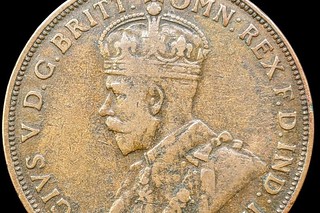 "All of those 1,500 would have gone into circulation, which means to get any of the 1930 coins that have any sort of reasonable condition is very rare."
"All of those 1,500 would have gone into circulation, which means to get any of the 1930 coins that have any sort of reasonable condition is very rare."
Ms Benson said it was not until the pre-decimal currencies were phased out in 1966 and enthusiasts began putting their coin collections together that anyone realised the 1930 coin was missing.
"It was only then that people realised how rare they were," she said.
Don adds:
"At today's rate of exchange, A$60,000 is almost exactly US$40,000 (A$1 = US$0.654)."
To read the complete article, see:
Rare Australian penny released during the Great Depression sells for nearly $60,000
(https://www.abc.net.au/news/2022-10-03/sa-rare-penny-sells-at-auction/101495852)
WASHINGTON FUNERAL URN MEDAL IN GOLD
Stack's Bowers published an article by Dave Bowers on the Washington Funeral Urn Medal in Gold. -Editor
Washington funeral medals were produced in several varieties in Newburyport, Massachusetts by well-known engraver Jacob Perkins and are believed to have been distributed at or for the civic funeral procession held in Boston. However, there were numerous civic processions arranged for nearby cities, and these medals might well have figured into more than one official event, as numerous die combinations are known suggestive of a fairly large output. Most were made in silver, holed for suspension. Gold strikes are extremely rare.
Born in Newburyport in 1766, Perkins showed an early aptitude for art and mechanics, and apprenticed to a goldsmith and jeweler in 1779. In business on his own account by 1783, he engraved dies for Massachusetts copper one-cent pieces in 1788. In the next decade he created innovations in the manufacturing of nails and the printing of bank notes, among other activities. In 1792 he sought but failed to get a position at the new United States Mint.
In Newburyport in 1800, Perkins created the Washington funeral medals and other issues that are not as well documented. A few years later he introduced the Patent Stereotype Steel Plate, which became widely used to print bank notes, and the siderographic process of transferring bank note vignettes to printing plates. His other inventions ranged from ship navigation devices to a steam-powered gun, to fire engines.
Perkins moved to England in 1818, where he remained for the rest of his life. There he printed the first postage stamps in the world, the British penny black
issues, with plates made by the siderographic process. After his death in London in 1849, the U.S. Patent Office devoted three pages of their annual report to his memory.
In our October 27-28 sale of the Sydney F. Martin Collection Part II at the Whitman Winter Expo in Baltimore, we are pleased to be offering Washington Funeral medals, including lot 2082, an About Uncirculated-53 gold medal.
To read the complete article, see:
JACOB PERKINS AND THE WASHINGTON FUNERAL MEDALS
(https://stacksbowers.com/jacob-perkins-and-the-washington-funeral-medals/)
Here's an excerpt from the lot description. -Editor
The earliest appearance we are aware of for a Funeral Urn medal in gold was W. Elliot Woodward's April 1863 sale, where one was secured by a Mrs. Paige for $55. Woodward commented that very few specimens exist in this metal
and that it is of the most extreme rarity,
the latter italicized for emphasis. Two years later, Woodward would describe another of these for sale, including the comment, a splendid original.
Though no further discussion on the point was made at this lot, it is clear that a question had arisen as to the status of these medals. The following year, he described yet another, the Hoffman specimen, by which point it seems that the controversy surrounding them had boiled over. Woodward declared here that several of these pieces have, from time to time, been sold as genuine, but it is now known that they are counterfeits, the dies having been in the possession of the late Dr. Edwards; they are now destroyed, together with all the pieces struck from them, excepting the few mentioned as having been sold to collectors.
The next to sell was cataloged by Edward Cogan in April 1866, for Colin Lightbody. That was noted as guaranteed original, and very rare.
It is difficult to know with certainty just what transpired, and it is easy to imagine that once the dies were discovered in Dr. Edwards' possession, Woodward (and others?) might have been too hasty in condemning them all. Jacob Perkins is known to have struck gold Washington funeral medals. An undated, but circa 1800 advertisement reprinted on page 140 of Neil Musante's, Medallic Washington, clearly illustrates that Perkins struck gold medals of Washington, and these, specifically for the ladies, have been taken to refer to the oval gold shells that are known to have been placed into lockets (as suggested directly by the advertisement). It is likely, therefore, that wealthy men of Boston or Newburyport might have wished gold impressions of Perkins' funeral medals for themselves and ordered them.
The dies were cut by the esteemed engraver Jacob Perkins, of Newburyport, Massachusetts and are believed to have been struck by him and distributed at or for the civic funeral procession held in Boston. As every town seems to have set aside its own day for memorial tributes, typically including well-planned processions, it is quite possible that Perkins could have capitalized on the opportunity in several nearby towns, if his work was complete in time. Processions are noted by us to have happened in Marblehead on January 2, Hallowell on January 8, Medford on January 13, and Haverhill on February 22. Certainly, there were many more. The number of dies prepared and the different compositions suggests a fairly large output. There were at least seven obverse dies and seven reverses used on medals bearing the funeral urn motif.
Gold funeral medals have long been markers of the greatest collections, as only the most advanced collections tend to include this most precious composition. Historic collections that included them go back to at least the 1860s and include owners such as Colin Lightbody (1865), Francis Hoffman (1866), Colin Lightbody (a second one, in 1866), Charles Bushnell (1882), Sylvester Crosby (1883), Lorin Parmelee (1890), Matthew Stickney (1907), Charles Gregory (1916), and W.W.C. Wilson (1925).
To read the complete lot description, see:
Circa 1800 Washington Funeral Medal. Funeral Urn. Musante GW-70, Baker-166. Dies 1-B. Gold. AU-53 (PCGS).
(https://auctions.stacksbowers.com/lots/view/3-ZA0A0/circa-1800-washington-funeral-medal-funeral-urn-musante-gw-70-baker-166-dies-1-b-gold-au-53-pcgs)
THE SHIRE POST MINT
Private mints are scarce these days, but many still exist and some are thriving. We've discussed products of the Shire Mint on occasion in the past; here's some backgound from their website. First, an introduction from their About Us page. -Editor
We are Shire Post Mint, a small, family-run coining operation located in Arkansas, USA. We specialize in licensed fantasy coinage, but we make lots of other things too.
Shire Post Mint began in 2001 when Tom bought his first antique coin press. He had a passion for coin collecting since his childhood and his years of knife-making gave him metalworking knowledge that he used to start making coins. The techniques used of hand-engraving steel dies and pressing one at a time are the same used in the 1800s and earlier. After a few years of research, refinement and building a small following online, his work caught the eye of George R.R. Martin, who was interested in having coins made from his new series of books, A Song of Ice and Fire.
Since then, Shire Post Mint has grown into an internationally recognized company known for attention to detail and a high level of craftsmanship, all while still being super nerdy!
In 2021, we moved into our new home: 7,000 sqft building in West Fork, Arkansas. You can now visit our gift shop where we sell our coins (made on site) as well as locally made products from other Arkansas small businesses. From the gift shop, you can peek into our manufacturing shop where we design and manufacture all of our designs!
A lengthy illustrated article by Helen Maringer describes how Shire Post Mint creates a fantasy coin, and it's a great overview of the classic minting process ingeneral. Here's an excerpt - see the complete article online, including several videos. -Editor
Coins are simply bits of metal that have been impressed with a design and are used as a medium of exchange. The basic process is that a "die" is created with a negative impression of the design. Two dies are then pressed or "struck" with the metal blank between. A fantasy coin is made in a few basic stages: design, engrave, blank, stamp, and finish.
Designing a fantasy coin
The coins we aim to make here at Shire Post Mint are in-world, meaning that they could come out of the pockets of a commoner or king. When designing, we look at the world as a whole and try to answer some basic questions: Who or what would be depicted on the coin: a ruler, an idol, a god, a symbol, or simply text? What would the coins be used for: a monetary system, exchange of information, advertising for a new ruler?
Once we have a basic concept, we move towards the design and more questions arise: What metals would they use? How big would these coins be? What would the text say? We often look back to Medieval and ancient world coinage to research art and engraving styles as well as the information often included on a coin. Engraver Greg Franck-Weiby used the same chisel-engraving technique for our Leif Ericsson Vinland coin as the Vikings used when making coins in the 9th and 10th centuries.
Our coin designs are 2D, often sketched by hand and aided by simple graphic design programs. The subtleties within the design (such as texture and depth) are up to the engraver in the next step.
Engraving the design
The first step in engraving is to reverse the design as the coin will come out as a mirror image. Tom's very first experiment with making custom coins came out backwards because he forgot this step! Many techniques can be used to engrave into tool steel including acid etching or the use of electric engraving tools. Here at Shire Post Mint we often use a pantograph machine, also known as a pantograph mill or reduction lathe, to begin the process. This allows us to take a large design and reduce and engrave it directly into the steel. The engraver controls the engraving point of the pantograph by "tracing" the 2D design with a stylus. A spinning bit cuts the same movements into the steel. The engraving with this machine is very basic and rough so all the finishing will be done by hand.
When the outline is done, Woody, our resident engraver, will use carving tools to continue the design. In the case of the viking coin shown earlier, the engraver used the same chisel-engraving technique that was used to make ancient coins.
When the engraving is finished, test strikes are done on a soft metal so as not to damage the dies. We keep a bit of the very soft metal indium in the shop for this purpose, but a thick piece of aluminum also works.
Above is a test Strike on Indium metal for Patrick Rothfuss' King Feyda Calanthis Breakable Vintish Penny, a coin launched December 2020 from the world of The Kingkiller Chronicles.
The article includes images of their original manual screw press, an electric screw press, an electric knuckle press, and a hydraulic press, as well as a discussion of the blanking and finishing processes. Great education for the numismatist. Check it out. -Editor
The Iron Coins of the Faceless Man go through a heat-based oxidation darkening process and then are tumbled to age them and bring out highlights. They are then dried and waxed to prevent rusting as they are made of pure iron.
To read the complete article, see:
How a Fantasy Coin is Made - Shire Post Mint's Process
(https://www.shirepost.com/blogs/news/how-a-fantasy-coin-is-made)
AUSTRALIA'S WOMEN ON BANKNOTES
This article discusses the history behind Australia's banknotes, which include a woman on every one. -Editor
In May 1990, when the Reserve Bank of Australia (RBA) announced plans to replace Caroline Chisholm with the Queen on a new $5 note, the decision stoked growing republican sentiment and unleashed a fiery backlash about the representation of Australian women on banknotes.
Paul Keating called the decision a national disgrace
. Historian Manning Clark described it as deplorable
and retrograde
. The mauve-coloured fiver was the first of a series of new polymer banknotes to be issued between 1992 and 1996 and there were concerns about what it might mean for the designs of the remaining notes, which had yet to be revealed.
The initial series of decimal currency, featuring 11 men and the Queen, was released in 1966, followed by a $5 note in 1967 depicting Caroline Chisholm, a 19th-century humanitarian, and the only Australian woman on the notes. Yet almost three decades later, she was first to go from the new polymer series.
As well as formulating monetary policy and maintaining a strong financial system, the RBA, which was established in 1960, is responsible for issuing currency and that includes producing banknotes. Its decision to replace Chisholm on the $5 note came in the wake of decades of campaigning for women's equal representation across all aspects of Australian society. That sparked anger and disgust from the Women's Electoral Lobby (WEL), which called for 50 per cent of the faces on banknotes to be of women. Labor MP for the Queensland seat of Forde Mary Crawford said the decision showed total disregard for women and women's place in our society
. Hundreds of schools and citizens petitioned the Parliament, urging the bank to reconsider.
Opinion writers of the day proposed women more suitable than the Queen, ranging from May Gibbs and Phyllis Cilento to Germaine Greer and Sophie Lee. Subsequently Australia Post weighed in, printing Chisholm's portrait on a new set of travellers cheques. Economically and financially, it was a pretty torrid time,
explains Selwyn Cornish, an economic historian at the Australian National University (ANU) and the RBA's official historian. Selwyn says the introduction of the new banknotes coincided with Australia's 1991 recession and the collapse of a couple of state banks. He says that ultimately the RBA's board decides who's on our banknotes – not the Parliament or the people.
In 1992, the RBA stuck staunchly by its decision to put the Queen on the Australian $5 note instead of Chisholm, citing the established tradition of depicting the monarch on our currency. But it also acknowledged there had been a mixed reception
to its decision and early in the saga RBA spokesperson Peter McWilliam assured The Canberra Times a woman will be represented, and possibly more
.
Soon, the bank revealed, a different woman would, in fact, be depicted on every single banknote. It was a decision that three decades later remains world-leading.
As well as carrying an image of the Queen, the polymer notes, which are still in circulation, feature palm-sized portraits of writer Dame Mary Gilmore, businesswoman Mary Reibey, first female member of an Australian parliament Edith Cowan and soprano Dame Nellie Melba. Australia remains the only country with a different woman depicted on every banknote, well ahead of the next best nations Denmark and Sweden.
Given that women feature on only about 15 per cent of banknotes globally, it's a striking achievement, particularly when compared with USA's greenbacks, where all the faces are currently men, despite efforts to have African American activist Harriet Tubman put on the $20 bill.
To read the complete article, see:
Face off: Australia's complicated history with the faces on its banknotes
(https://www.australiangeographic.com.au/topics/history-culture/2022/10/face-off-australias-complicated-history-with-the-faces-on-its-banknotes/)
LOOSE CHANGE: OCTOBER 9, 2022
Here are some additional items in the media this week that may be of interest. -Editor
Australia is among the countries debating whether to replace Queen Elizabeth II on their paper money. -Editor
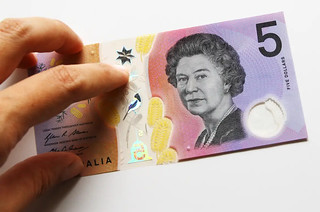 Debate over which famous faces should appear on the country's currency has reignited, with two dedicated fans campaigning in a desperate attempt to get one Aussie icon into our wallets.
Debate over which famous faces should appear on the country's currency has reignited, with two dedicated fans campaigning in a desperate attempt to get one Aussie icon into our wallets.
Principal petitioners Vincent Wu and Kirby Miles have started two separate petitions in a bid to feature crocodile hunter
Steve Irwin on the $5 note.
Their goal is to have the Australian conservationist, wildlife expert and TV personality's portrait feature on the lowest value note opposed to that of King Charles III.
And their hopes may become a reality after Assistant Treasury Minister Andrew Leigh revealed that the new king may not necessarily replace his mother on the $5 note in the way new coins will feature him.
The endless possibilities of who could replace the Queen on the note has amassed discussion online, even attracting international attention.
Hi I'm American, can we replace Andrew Jackson on our money with Steve Irwin? We love him too,
one international fan tweeted.
To read the complete article, see:
Australians petition to put Steve Irwin on new currency, replacing Queen Elizabeth
(https://nypost.com/2022/10/02/australians-petition-to-feature-steve-irwin-on-new-5/)
Moving from Australia to Austria, a Coin Update piece by Michael Alexander looks at their new five-euro coins. Interesting design - I like it. -Editor
The Austrian Mint has released new collector coins which mark the occasion of the reopening of the Parliament building in Vienna.
The obverse design is the work of Helmut Andexlinger and Rebecca Wilding and features two heads in profile and one facing front which represents the Austrian people as sovereign. To the left is a watchful eye surrounded by stylised laurel leaves and to the right is a section of the Austrian Parliament building in the background. Another part of the design illustrates the spirit from which the Austrian Republic was born and includes text from Austria's Constitution ÖSTERREICH IST EINE DEMOKRATISCHE REPUBLIK – IHR RECHT GEHT VOM VOLK AUS (Austria is a Democratic Republic – Its laws emanate from the people) the words are seen on the top and bottom edges of the coin along with the year of issue, 2022. The standard reverse design on copper and silver versions depicts each of the nine cantonal coats of arms arranged in a circle on the value side of the nine-sided coin. The crests are surrounded with the text REPUBLIK OSTERREICH along with the denomination of 5 EURO, the numeral 5 is centred.
Of particular interest is the base metal five-euro version, which is unlike any coins previously minted in Austria. The Democracy €5 coins are struck from the old copper sheeting recovered from the former roof of the Parliament building in Vienna. By recycling the copper from the Parliament's refurbishment, it is hoped the ideals of the Republic itself will be a special keepsake for many and a permanent part of Austrian coinage.
To read the complete article, see:
Austria: New five-euro coins focus on democracy and the reopening of the Parliament building
(https://news.coinupdate.com/austria-new-five-euro-coins-focus-on-democracy-and-the-reopening-of-the-parliament-building/)
FEATURED WEBPAGE: JAMES BEARD AWARDS
For foodies, this week's Featured Webpage is the James Beard Awards. Entries and recommendations for the 2023 awards can be made through November 30, 2022.
The mission of the James Beard Awards is to recognize exceptional talent and achievement in the culinary arts, hospitality, media, and broader food system, as well as a demonstrated commitment to racial and gender equity, community, sustainability, and a culture where all can thrive.
https://www.jamesbeard.org/awards
Who is the artist who created the medal? There's a name on the shoulder - it looks like "BADIA". Below is another image of the medals. Luigi Badia "signed both LB and LSB as monogams on medals", according to Dick Johnson's databank. Badia designed the 2004 Carnegie Hero Fund Century of Heroes Medal with an LB monogram. Has he signed other medals with his full last name?. -Editor

